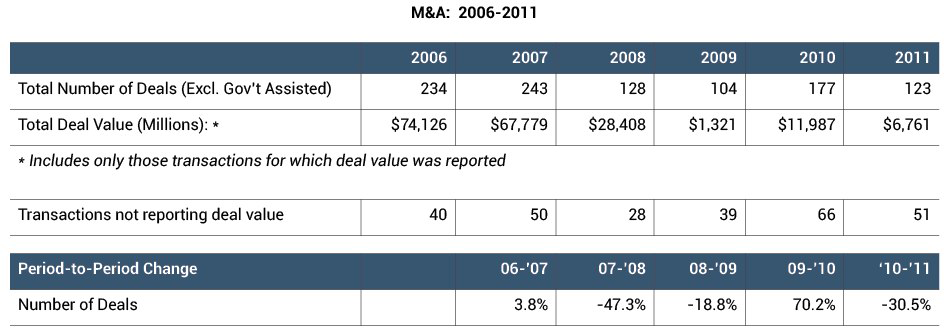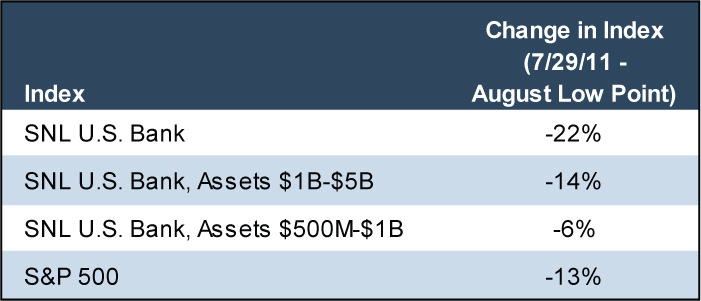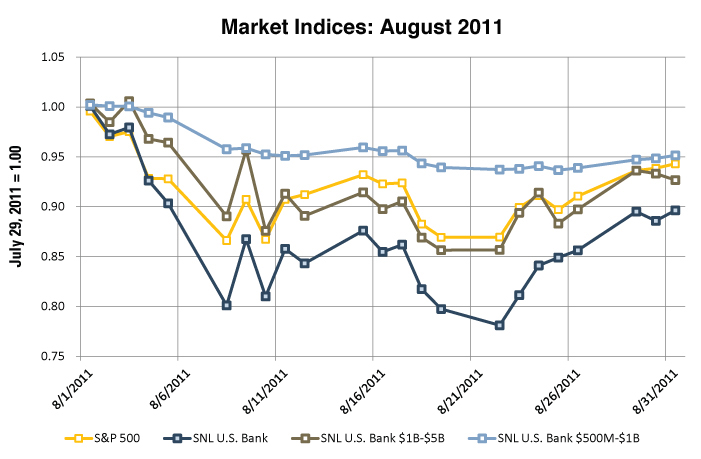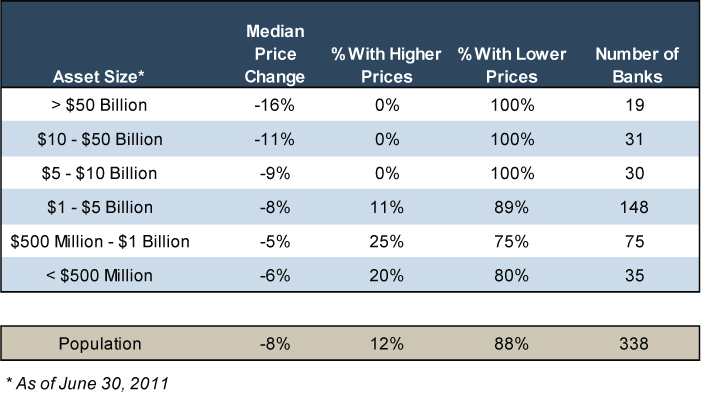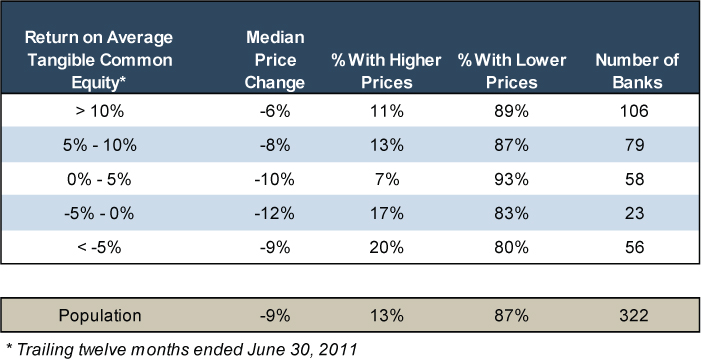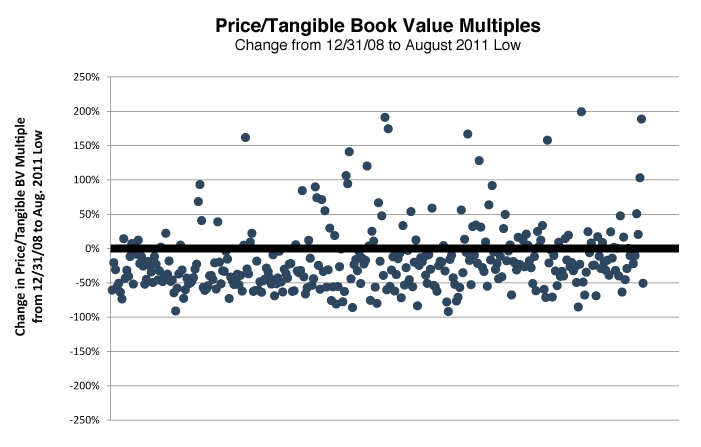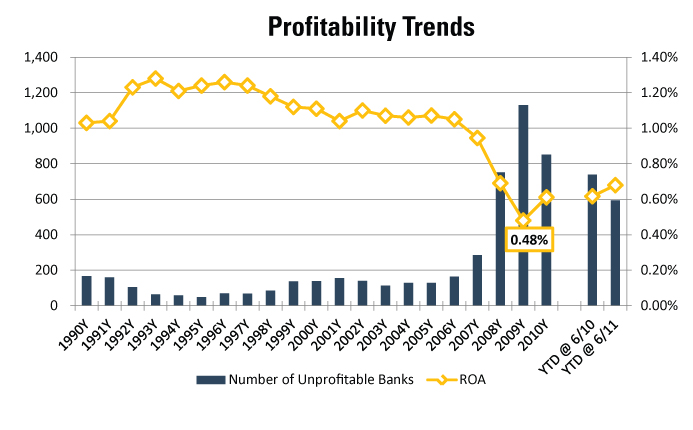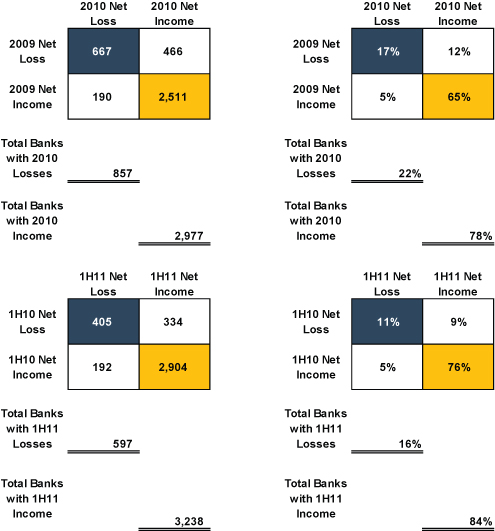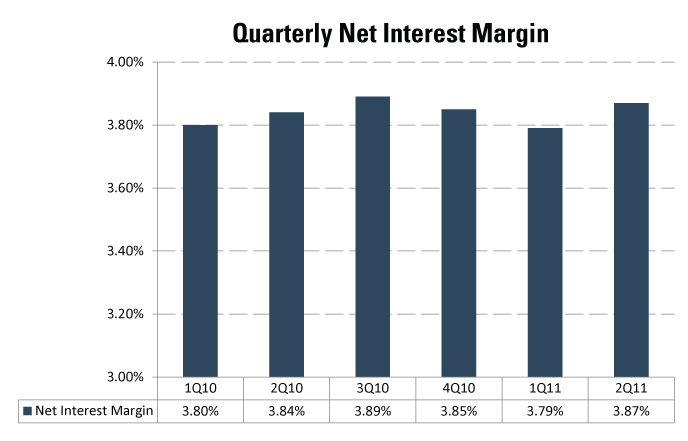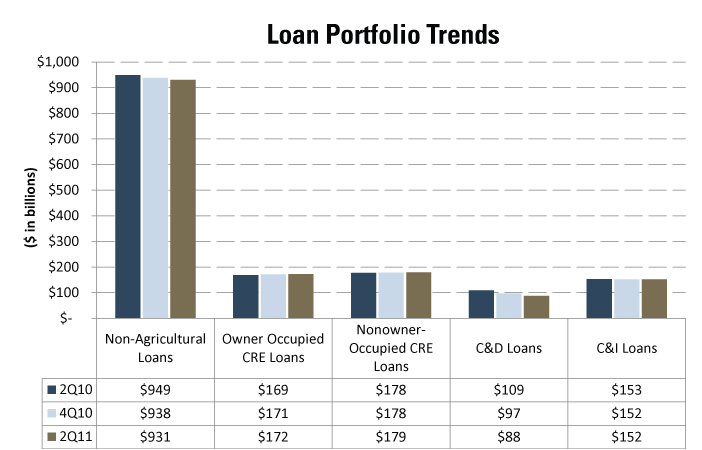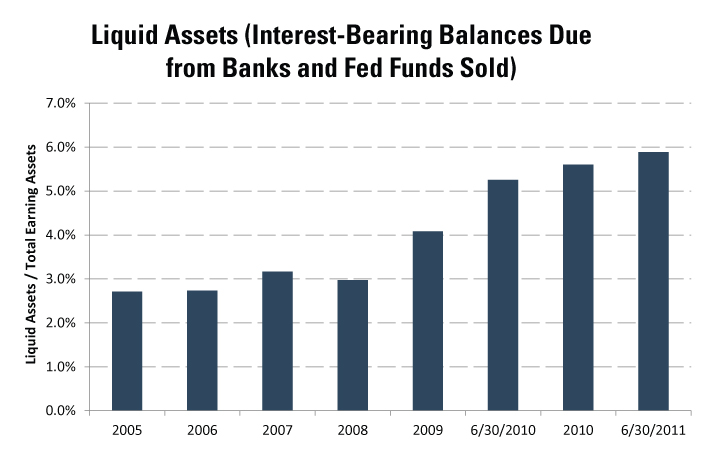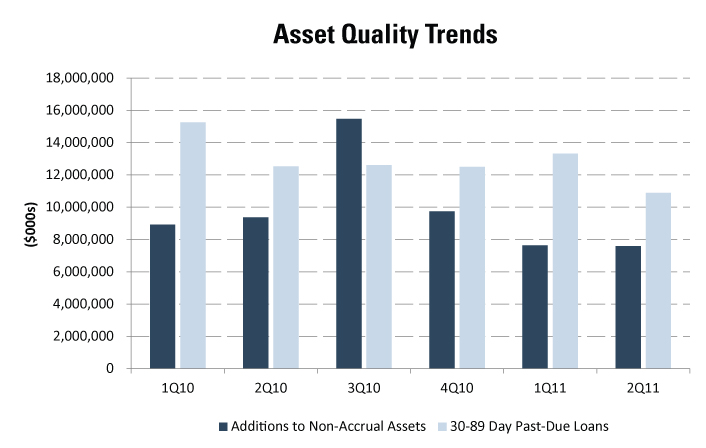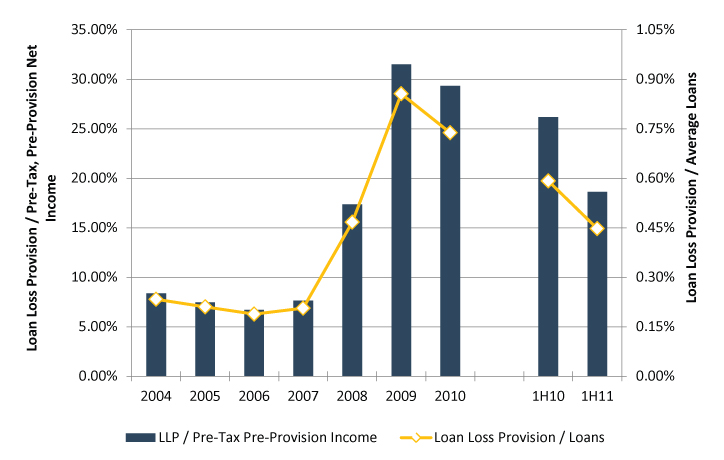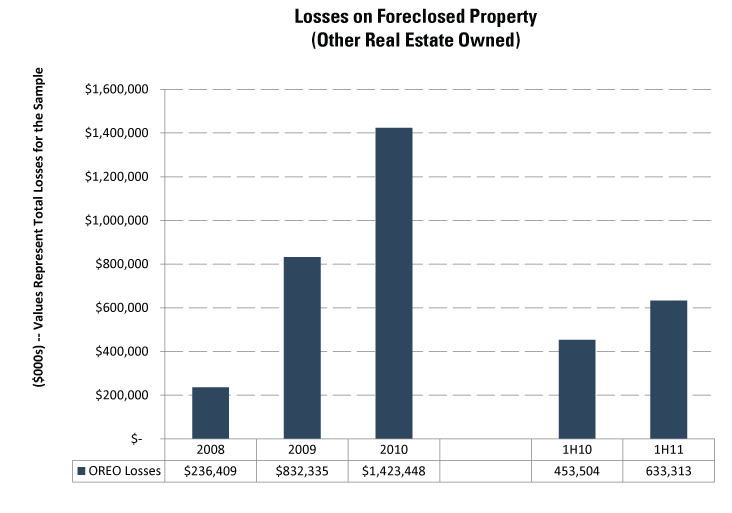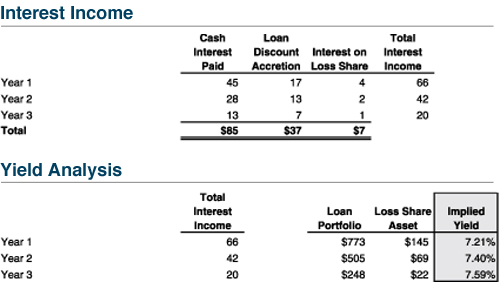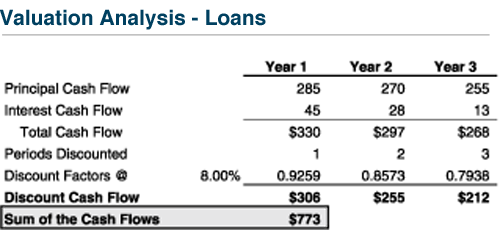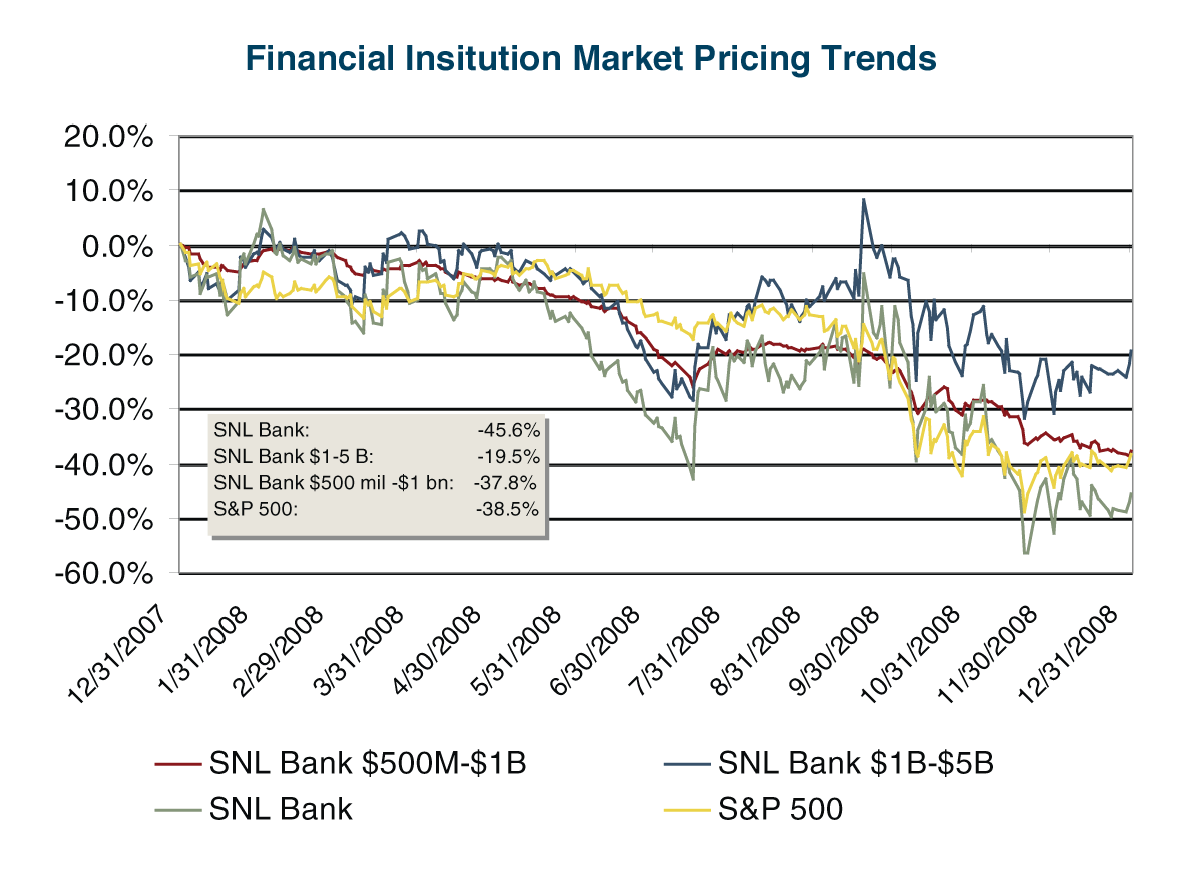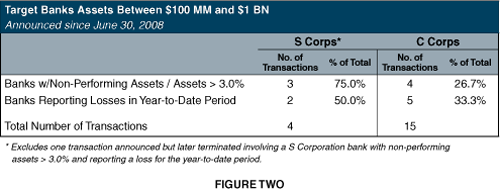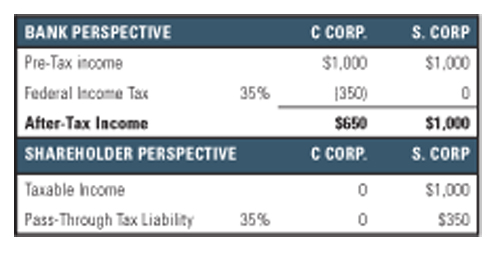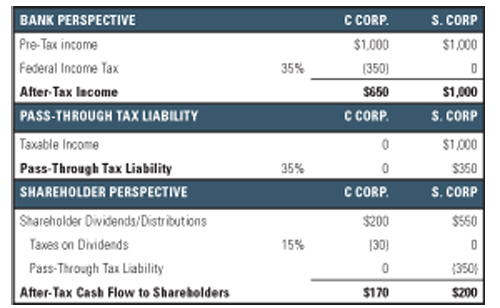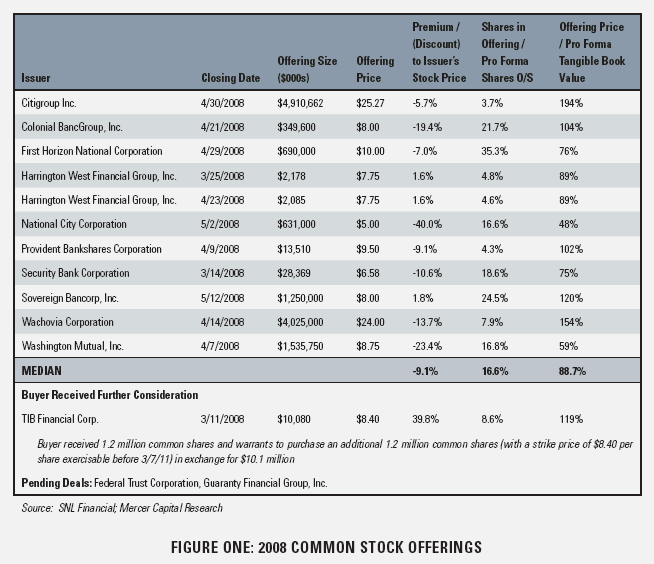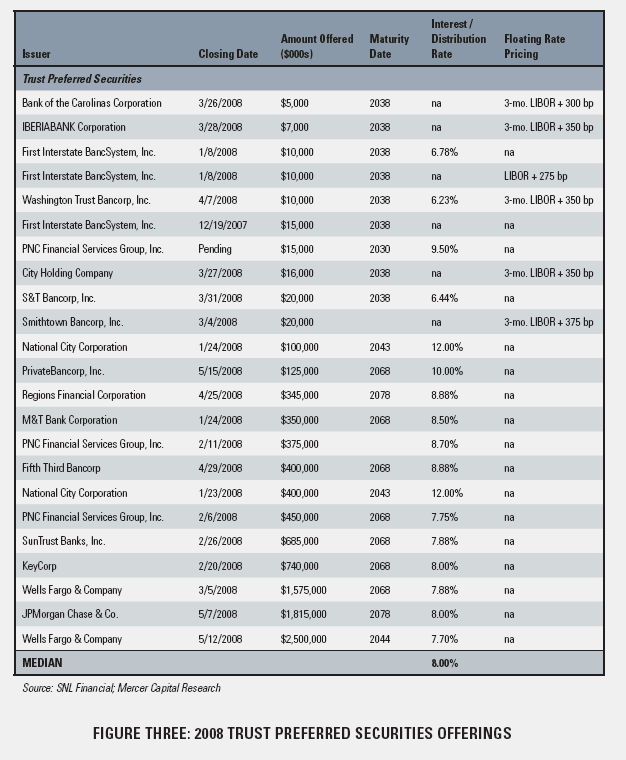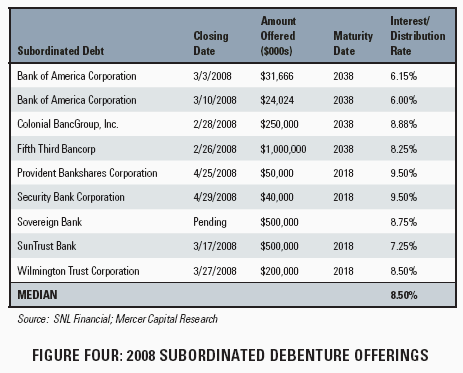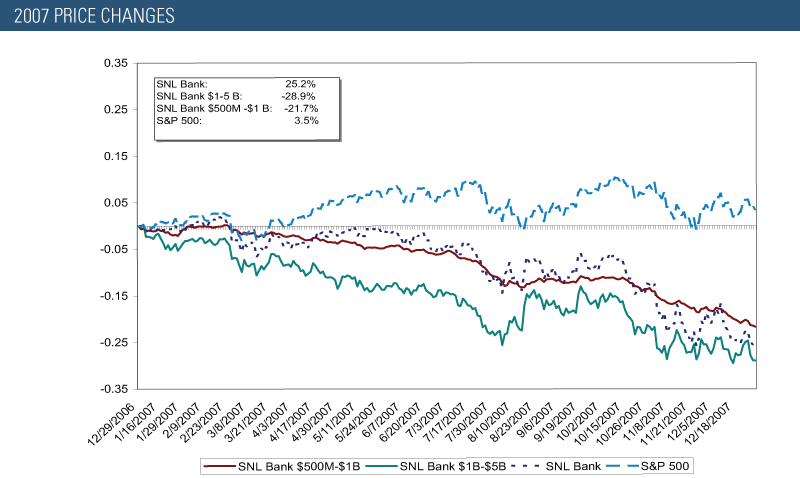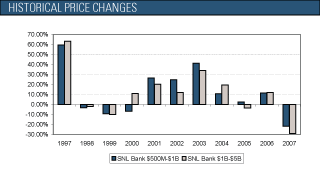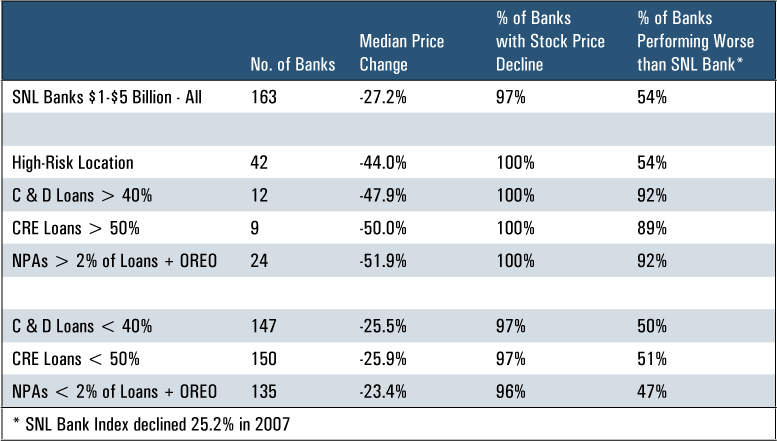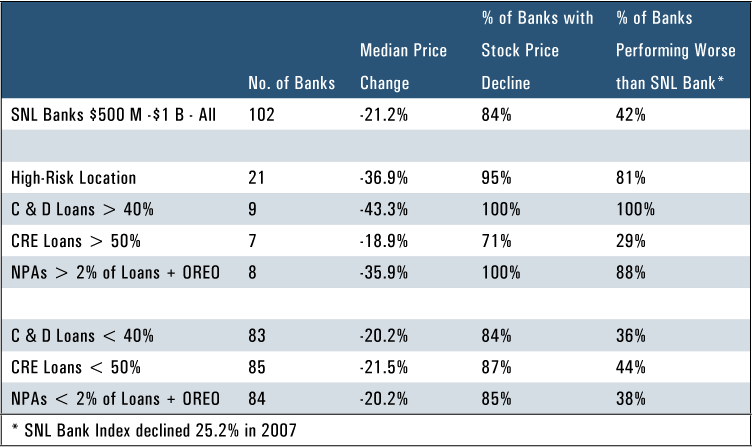Bank Merger & Acquisition Review: 2011 & Q1 2012
Despite an anticipated surge of transactions within the banking industry, bank merger and acquisition activity declined in 2011 compared to the prior year, hindered by a weak economic recovery, mounting regulatory pressures, and, according to some analysts, excessive seller expectations. Deal volume excluding government assisted transactions decreased 15.8% in 2011 from 2010 levels and approximated 2008 levels. It appears deal volumes bottomed out in 2009 at a total of 104 for the year. Unfortunately, the number of transactions not reporting a deal value has increased in recent periods (from 39 in 2009 to 51 in 2011), making a comparison of trends in deal values difficult. The number of deals presented is exclusive of FDIC-assisted transactions, which decreased to 92 in 2011 from 157 during 2010.
Deal value (for those transactions which reported it) totaled $6.8 billion in 2011 versus $11.7 billion in the prior year. Total deal value included PNC’s $3.5 billion acquisition of RBC Bank, which was announced in the second quarter of 2011, completed in the first quarter of 2012, and represented 51% of total reported deal value in 2011. Comerica’s $1.0 billion acquisition of Sterling Bancshares (announced in the first quarter and completed in the third quarter) accounted for 15% of total deal value during the year.
Notably, total deal value for transactions in 2010 included several sizeable acquisitions, such as BMO’s purchase of Marshall & Ilsley Corporation ($5.8 billion), Hancock Holding Company’s purchase of Whitney Holding Corporation ($1.8 billion), and First Niagara Financial Group’s purchase of NewAlliance Bancshares, Inc. ($1.5 billion). The following table provides additional perspective with regard to transaction activity in the banking industry since 2006.
As in 2010, the majority of acquisitions involved sellers with assets less than $500 million. As shown below, for deals for which pricing multiples and deal value were available (a total of 72 transactions), 56 transactions, or more than 75%, involved targets with assets less than $500 million.
Twenty-one of the 72 transactions for which pricing information was available were all-cash transactions, 35 deals involved some mixture of cash and other consideration (generally common stock), and 10 transactions involved common stock as currency. The remaining deals were unclassified or not reported.
Regional economic viability again affected transaction volume during the year. Deal volume was highest in the Midwest and West regions1, which reported 24 and 19, respectively, of the 72 total transactions with pricing multiples. The Atlantic Coast and Northeast regions followed with 11 deals each in 2011. Seven transactions occurred in the Southeast region. For comparison, FDIC-assisted transactions, which totaled 92 in 2011 compared to 157 in 2010, continued to be concentrated in states with severely depressed real estate markets, such as Florida and Georgia (both in the Southeast region), which had 13 and 23 bank failures, respectively, during 2011. Illinois and Colorado followed with nine and five failures, respectively, and all remaining states reported less than five failures each during the year.
Through March of 2012, a total of 16 bank failures were reported with eight attributable to the Southeast region. Florida and Tennessee each reported two failures, while Georgia reported four, and Illinois reported three failures. For comparison, through March of 2012, transaction volume was higher with 56 total deals reported (compared to 47 in the first quarter of 2011). Total reported deal value through the first quarter of 2012 was also higher at $3.0 billion (compared to $1.5 billion in the first quarter of 2011) and included Mitsubishi UFJ Financial Group’s $1.5 billion acquisition of Pacific Capital Bancorp as well as Prosperity Bancshares’ $529 million acquisition of American State Financial Corp. Deal volume in the first quarter of 2012 was weakest in the Northeast, where four transactions occurred, while deal volume was higher in the Midwest and Southeast, which reported 25 and 13 transactions, respectively.
Some analysts have attributed the heightened transaction activity in the first quarter of 2012 to the improved economy and an increased confidence among buyers, and, in particular, confidence with regard to loan portfolio assessment. Transaction activity going forward is expected to remain concentrated among smaller institutions in light of revenue and regulatory challenges. However, uncertainty concerning regulatory changes and the resulting burdens placed on institutions (smaller ones in particular), coupled with market volatility and the heated political climate, still looms, threatening any impending, potential surge of transaction activity.
Furthermore, capital raising remains difficult, and lackluster market activity caused many institutions to look to private equity firms as a source of capital in 2011. Preferred stock issuances were successful for several firms during the year, and some analysts expect more buyers to utilize such issuances to finance acquisitions when consolidation activity resumes.
Endnote
1 The regions include the following states:
- Atlantic Coast – Delaware, Florida, Maryland, North Carolina, South Carolina, Virginia, West Virginia, Washington, D.C.
- Midwest – Iowa, Illinois, Indiana, Kansas, Michigan, Minnesota, Nebraska, North Dakota, Ohio, Oklahoma, South Dakota, Texas, Wisconsin
- Northeast – Connecticut, Maine, Massachusetts, New Hampshire, New Jersey, New York, Pennsylvania, Rhode Island, Vermont
- Southeast – Alabama, Arkansas, Georgia, Kentucky, Louisiana, Missouri, Mississippi, Tennessee
- West – Alaska, Arizona, California, Colorado, Hawaii, Idaho, Montana, Nevada, New Mexico, Oregon, Utah, Washington, Wyoming
Originally published in Mercer Capital’s Bank Watch, May 2012.
3 Ways a Loan Portfolio Valuation Is Helpful to the Acquirer
Mercer Capital works extensively with both the management of an acquirer and their loan review personnel (both internal and external) to obtain an in-depth understanding of loans being acquired. We provide a detailed valuation model along with extensive documentation to support our analysis of the fair value of the subject loans, reflective of the credit risk embedded therein.
Our clients find these analyses helpful both when assessing a target initially and when accounting for the acquired loans at the transaction closing date. Here are three ways that a loan portfolio analysis is helpful to your bank when considering an acquisition.
- Assess the Target’s Credit Risk More Quickly and Accurately. The successful acquirer typically assumes all the credit risk inherent in the target institution, and failure to properly assess this risk typically hurts the acquirer’s ability to generate a profitable return on the capital allocated to complete the acquisition. A timely and accurate valuation of the loan portfolio is necessary to assess the target’s credit risk prior to closing, particularly when the target is relatively weak and both information and time are limited.
- Improve the Decision-Making Process. By obtaining a loan portfolio valuation, managers and directors gain a better understanding of the credit risk inherent in the portfolio, and the outlook for future performance of different segments of and individual credits in the portfolio. This enhances discussions among management and directors and provides a more detailed basis for submitting offers for the target and estimating the pro forma impact on capital ratios and earnings from the acquisition. Additionally, having an independent third party analyze the target’s loan portfolio frees up members of the acquirer’s due diligence team to assess and resolve other merger-related issues.
- Reduce the Potential for an Accounting Surprise. Merger-related accounting issues for bank acquirers are often complex. An assessment of the loan portfolio prior to closing provides management, directors, and their auditors an opportunity to evaluate, in advance, the methodology employed to value the acquired loans, as well as the potential impact on the acquirer’s balance sheet and earnings going forward. This reduces the likelihood of surprises when the fair value of the loan portfolio is determined on the transaction closing date. Further, materially incorrect credit and interest rate marks relative to the loan portfolio valuation at the acquisition closing date leads to delays in subsequent monthly closings and the inability to meet other financial reporting requirements.
In addition to loan portfolio valuation services, we provide acquirers with valuations of other financial assets and liabilities acquired in a bank transaction, including depositor intangible assets, time deposits, and trust preferred securities. We are always happy to discuss your valuation issues in confidence as you plan for a potential acquisition. Give us a call today.
A Review of Bank Stock Performance in August 2011: The “New Normal?” and Other Observations
Bank stocks ended a particularly volatile month in August 2011 on something of a good note, which masked the intra-month volatility. Looking forward, does this greater stock price volatility represent a “new normal,” as banks face an environment marked by greater macroeconomic risk?
Three bank stock indices we track performed as follows in August, relative to the S&P 500:
While the deterioration in market values evident in the table above is substantial, the declines are even more significant when measured at points earlier in the month. Table 2 indicates the compression in market values between July 29, 2011 and the lowest point observed for each index in August1:
For example, the aggregate SNL Bank Index declined by 22% between July 29, 2011 and its August 22nd low, although subsequent gains cut this loss to 10% by month-end. Chart 1 provides daily observations for the four indices during August 2011.
The volatile performance appeared to be driven by various factors:
- Rising concern about a weakening global economic outlook and potential “double dip” recession in the U.S.;
- The inability of European governments to develop a successful strategy for managing their sovereign debt crisis, coupled with rising fears about a potential debt default by Spain and/or Italy;
- Concerns about the financial and reputational impact on larger banks of their entanglements with various issues and litigation related to securitized residential mortgages. This led to concerns that some banks (particularly Bank of America) may need to raise additional capital on dilutive terms (which Bank of America did via a preferred stock offering to Berkshire Hathaway); and,
- The U.S. debt downgrade by Standard & Poors.
While these general factors affected most stocks in August, we attempted to isolate which factors most affected the performance of publicly traded banks in August. The following table shows the performance of banks in August stratified by asset size.
At August 31, 2011, no banks with assets exceeding $5 billion reported a higher stock price than at July 29, 2011, and larger banks generally reported weaker performance than smaller banks. This reflects several factors:
- The larger banks are more exposed to the lingering effects, such as lawsuits and loan repurchase demands, of residential mortgages originated at the peak of the real estate market;
- The larger banks may have direct exposure, albeit reportedly limited, to the sovereign debt of struggling European nations and entities located therein;
- The larger banks tend to be held more widely among various index funds, as compared to the smaller banks, which may create more selling pressure in a market where investors sell stocks in favor of safer alternatives; and,
- The smaller banks tend to trade less actively and often are less correlated with the broader equity market. Further, some of the smaller banks trade at very low nominal stock prices, due to their asset quality problems and capital shortfalls, and month-to-month movements in their stock price can be exaggerated and analytically less meaningful.
We also examined the relationship between August 2011 stock market performance and return on tangible common equity. As indicated in the following table, banks with stronger profitability generally performed better, as measured by the median change in their respective stock prices, providing some evidence that investors were more apt to avoid banks with lower profitability, since such banks may have less wherewithal to manage more distressed economic conditions.
Given the depths to which some bank stocks fell in August, we thought it interesting to compare the price/tangible book value multiples, measured based on each bank’s lowest stock price during the month, to the price/tangible book value multiples observed as of December 31, 2008, which represents a proxy for the timing of most distressed period of the financial crisis. This analysis indicates the following:
- Only 80 banks had a higher price/tangible book value multiple at their August 2011 low than at December 31, 2008, which represents 24% of the population of actively traded banks. That is, despite the improving trends in credit quality and rising earnings, more than 75% of the publicly traded banks had lower price/tangible book value multiples at some point in August 2011 than at year-end 2008;
- The trend towards lower price/tangible book value multiples was not limited to smaller banks for which the effects of the weaker economic conditions were often not immediately evident in 2008. Even larger banks, such as Bank of America, JPMorgan Chase, and Wells Fargo reported lower price/tangible book value multiples.
For perspective, the chart below plots the changes in the price/tangible book value multiples reported by the publicly traded banks between December 31, 2008 and their respective August 2011 lows.
Endnotes
1 These low points occurred on August 8th for the S&P 500; August 19th for the SNL Bank Index comprised of banks with between $1 and $5 billion of assets; August 22nd for the aggregate SNL Bank Index; and August 25th for the SNL Bank Index comprised of banks with between $500 million and $1 billion of assets.
Originally published in Mercer Capital’s Bank Watch 2011-09, released September 15, 2011
Community Banks: Gradual Improvement Continues in the First Half of 2011
Earlier this year, we presented a review of community banks’ 2010 financial performance, which reflected a mixed bag – some metrics improved, while others deteriorated. With the mid-year filing cycle complete for banks’ Call Reports, we updated this analysis to assess whether the trends noted in 2010 have persisted. In general, we conclude that trends continue to improve, although the pace of improvement appears to be slowing for some metrics.
The analysis relies on a data set comprised of approximately 3,800 commercial banks with assets between $100 million and $5 billion. Additionally, we excluded banks owned by non-U.S. domiciled bank holding companies, subsidiaries of holding companies with more than $5 billion of assets, and banks with unusual levels of non-interest income or consumer lending. As a result, the data set does not have the bias evident in some analyses of aggregate banking industry data, which are weighted in favor of the largest domestic banks.
Income Statement
Reflecting community banks’ steady profitability improvement, 597 banks reported a loss in the first half of 2011, down from 739 in the first half of 2010 and 857 in fiscal 2010. However, the gradual nature of the improvement in performance is evident in the industry’s return on assets – the median bank’s return on assets improved from 0.62% in the first half of 2010 only to 0.68% in the first half of 2011, which remains well below the pre-crisis level that exceeded 1.00%. The improvement realized relative to the first half of 2010 is driven largely by lower loan loss provisions.
The following matrix groups community banks based on their net income into four categories including (a) positive net income in both the first half of 2010 and the first half of 2011, (b) net losses in both the first half of 2010 and 2011, or © positive net income in one period and a net loss in the other period. As indicated in the matrix, 76% of banks reported positive net income in both periods, while 11% reported net losses in both periods.
Figure Two
Net interest margin enhancement contributed to many community banks’ improving performance. For example, in fiscal 2010, net interest margin expansion benefited about 60% of the banks in the analysis. However, data from 2011 suggest that the trend of rising net interest margins is weakening. For the first half of 2011, approximately one-half of the banks in the sample reported higher net interest margins than in the first half of 2010.
After declining for the last two quarters, the median net interest margin widened in the second quarter of 2011, suggesting that community banks continue to benefit from deposit rate reductions.
Balance Sheet
For a majority of the community banks in the analysis, loan growth has not yet resumed. As of June 30, 2011, 62% of community banks reported lower balances of non-agricultural loans, as compared to December 31, 2010 – a trend consistent with the 58% of banks that reported lower loan balances at year-end 2010 than at year-end 2009. The aggregate loans outstanding held by community banks declined by 0.79% between year-end 2010 and June 30, 2011. However, the contraction was not spread evenly throughout loan portfolios. Instead, construction and development loans continue to shrink, offsetting growth in commercial real estate (both owner and non-owner occupied) and commercial and industrial loans.
Figure Four
Liquidity continues to accumulate within the community banking industry, albeit at a somewhat slower pace than in recent years, as indicated in the following table showing the median ratio of liquid assets to total earning assets. Offsetting this increase, the median ratio of loans to earning assets declined from 74% at June 30, 2010 and December 31, 2010 to 71% at June 30, 2011.
Asset Quality
One notable trend in fiscal 2010 among community banks was the steady quarterly increase in non-performing assets, despite a gradually recovering economy. After reaching 3.78% in the first quarter of 2011, the median ratio of non-performing assets to loans and other real estate owned decreased by four basis points in the second quarter of 2011, marking the first decline in this ratio since the second quarter of 2006.
As further evidence of the gradual improvement in asset quality, new additions to non-accrual assets dropped below $8 billion (in aggregate for the 3,800 banks) in both the first and second quarters of 2011 – a level below any quarter in 2010. In addition, loans past-due 30-89 days, representing potential future non-accrual loans, fell to $10.9 billion at June 30, 2011, the lowest level since at least the first quarter of 2010.
Similar to the trend reported by larger banks in their mid-year earnings releases, community banks continue to see reductions in loan loss provisions. The aggregate loan loss provision reported by the 3,800 banks in the data set declined by 32% in the first half of 2011, versus the same period in 2010. For the median bank, the annualized loan loss provision dropped to 0.45% of loans in the first half of 2011, as compared to 0.59% in the first half of 2010. To some degree, though, credit costs have shifted within the income statement from loan loss provisions to losses and other costs related to other real estate owned. In the first half of 2011, losses on sale of other real estate owned increased by 40% versus the first half of 2010.
For the second half of 2011, trends to monitor include:
- Whether the reduction in the median ratio of non-performing assets/loans and other real estate owned represents the beginning of a trend or a one-time occurrence
- The impact of the stock market declines in early August 2011, the U.S. sovereign debt credit rating downgrade, and the European debt crisis on community banks. While the direct impact may be muted, banks may not escape an indirect effect if macroeconomic conditions deteriorate further
- The levers available to banks to improve earnings, as the boost from lower loan provisions begins to wane. Also in this vein, the second half of 2011 will allow the first opportunity to assess the impact, if any, of the Durbin amendment on community banks
Originally published in Mercer Capital’s Bank Watch, released August 15, 2011.
Bank Merger and Acquisition Review: A Look Back at 2010 and Look Forward to 2011
For several years now, industry experts have been predicting a wave of bank consolidation. The initial reasoning was that weaker banks would be absorbed by stronger banks, many against their will when faced with the choice of merger or failure. As time passed the industry realized that even the healthiest institutions were either unwilling or unable (sometimes both) to take on the debt, shareholder dilution, and asset quality problems that come along with an acquisition.
At present, the presumed M&A driver for the near-term is regulatory changes, which will place a substantial burden on institutions. The smaller the institution, the theory goes, the more onerous the burden and the more diminished the ability to absorb the associated costs. The only solution, many argue, is to grow organically (not easily done in the current environment) or find strategic combinations that will create a bank large enough to support the additional operating expense.
Is this wave of predicted merger activity finally coming to fruition? One might think so, based on the uptick in announced bank deals in 2010. According to SNL Financial, LLC there were 205 announced deals in 2010, compared to 175 announced in 2009. This does not include the 157 FDIC-assisted transactions which occurred during the year. Additionally, deal value was substantially higher in 2010, at $11.8 billion, compared to $2.0 billion in 2009. The increase in total deal value was supported by a few larger acquisitions, including BMO’s purchase of Marshall & Ilsley Corporation ($5.8 billion), Hancock Holding Company’s purchase of Whitney Holding Corporation ($1.8 billion), and First Niagara Financial Group’s purchase of NewAlliance Bancshares, Inc. ($1.5 billion).
However, the M&A story in 2010 lies within the realm of the community bank. As shown below, for deals in which pricing multiples and deal value are available (a total of 111 transactions), 84 transactions, or more than 75%, involved a seller with assets less than $500 million.
What is notable in the table above is that the size of the seller appears to be negatively correlated with the pricing multiples received, particularly on a book value basis.
The smallest banks were the only group which reported a median purchase price at a premium to book value, both reported and tangible. Of course, it is worth noting that the larger groups contain a fewer number of transactions, and perhaps reflect a more dire situation on the part of the seller, who presumably has little incentive to sell in the current pricing environment.
Cash remained king in 2010 as the most common form of transaction funding. Forty of the 111 transactions reporting multiples were all-cash acquisitions, followed closely by 38 which were some mixture of cash and other consideration (generally common stock). Capital contributions accounted for eighteen of the transactions and common stock was used as currency in six of the transactions. The remainder were unclassified or not reported.
The banking industry has always exhibited a proclivity to finance acquisitions using cash on hand. However, it is no surprise that buyers, who likely are facing their own problems with low stock valuations, are reluctant to dilute shareholders by using what many consider to be an undervalued asset to fund purchases. After all, pricing multiples in the public marketplace remain well off the highs of 2006 and 2007, when bank stocks commonly traded at price-to-earnings multiples approaching twenty times and book value multiples as high as three times. Additionally, with the universe of transactions focused on smaller institutions, many do not have publicly traded equity, and sellers often frown on accepting illiquid stock as transaction currency.
In terms of geography, there was a distinct relationship between the economic health of various regions and the volume of transaction activity. During 2010 the concentration of FDIC-assisted transactions (i.e., bank failures) centered around states with severely disrupted real estate markets, such as Florida (29 failures), Georgia (21 failures), Illinois (16 failures), California (12 failures), and Washington (11 failures). Perhaps not surprisingly, non-assisted transaction activity was highest in regions without a high level of bank failures, as shown in the table below (includes only those deals reporting pricing multiples).1
The next logical question is what will 2011 hold for bank M&A activity? While we do not have a perfectly clear crystal ball, here are a few things to consider:
- The new regulations that will come as a result of the Dodd-Frank Act, once they are written, will most likely hamper a bank’s ability to generate fee-based income, which is an increasingly large portion of the bottom line for most financial institutions.Many industry insiders believe there is a “magic” size that a bank will need to be in order to absorb the additional costs and lower revenues inflicted by the new regulations. Whether that number is $500 million or $1 billion in assets, popular figures at the moment, or some other amount, there will be a measurable number of banks that are below the threshold.While some may resist the urge to merge, and indeed some will face specific circumstances that allow them to survive despite their smaller size, there is certainly an impetus for mergers of equals and for smaller institutions to begin shopping themselves to the highest bidder.
- Because of increasing regulatory burdens, we have heard from life-long bankers on a number of occasions that they simply no longer enjoy what they are doing.Many, who are second and third generation bankers, have entertained the idea of selling the bank in order to avoid the extreme headache which comes along with increasing regulatory oversight. While these thoughts may be dampened somewhat when it comes time to put pen to contract, and particularly in light of the current pricing environment, it is a real trend that could lead to more institutions being marketed for sale in the next several years.
- While there may be more banks for sale and more incentive to merge, financing such purchases may be easier said than done.Capital remains difficult to come by for financial institutions, and both market and non-market forces are responsible culprits. First, regulators are requiring a higher capital cushion from banks, a requirement with which a large portion are not in compliance at present. It will take a number of years to build up adequate capital levels, particularly given that most increases in capital will likely have to come from retained earnings as investors remain hesitant to contribute additional capital to all but the healthiest banks. Secondly, the issuance of new trust preferred securities, which previously were a relatively cheap and accessible source of capital for financial institutions, has been virtually eliminated by the Collins Amendment to the Dodd-Frank Act, which prohibits this form of capital for larger institutions and only grandfathers in existing trust preferred securities for smaller banks.
- FDIC-assisted transactions are likely to continue at a rapid clip, as the problem bank list stood at 884 for the fourth quarter of 2010, compared to 702 banks at year-end 2009 leading into a year where we saw 157 bank failures.For banks that are actively pursuing a strategy involving growth by acquisition, there is little incentive to pay full market price for a healthy institution when the failed banks marketed by the FDIC are available at such extensive discounts, even despite the associated bidding, asset quality, and other problems related to purchasing a failed bank.
- While outside investors have, up to this point, been effectively shut out of the market for whole-bank purchases, the tide seems to be turning.A number of private equity acquirers participated in FDIC-assisted transactions in 2010, which previously had generally been frowned upon by the FDIC. Additionally, private equity firms have recently been allowed to file shelf charters which allow them to quickly form a bank holding company for purposes of acquiring an existing institution. Purchases of banks and bank holding companies must to be approved by regulators, who up to this point have shown a preference that the acquirer be another bank. An additional subset of buyers in the market can only serve to increase demand, transaction activity and, most likely, pricing multiples.
Will 2011 be the year of the bank merger? Signs remain mixed, but it appears conditions are favorable at the very least for an increase in merger activity. Then again, we have definitely heard that before.
ENDNOTES
1 The regions include the following states:
- Atlantic Coast – Delaware, Florida, Maryland, North Carolina, South Carolina, Virginia, West Virginia, Washington, D.C.
- Midwest – Iowa, Illinois, Indiana, Kansas, Michigan, Minnesota, Nebraska, North Dakota, Ohio, Oklahoma, South Dakota, Texas, Wisconsin
- Northeast – Connecticut, Maine, Massachusetts, New Hampshire, New Jersey, New York, Pennsylvania, Rhode Island, Vermont
- Southeast – Alabama, Arkansas, Georgia, Kentucky, Louisiana, Missouri, Mississippi, Tennessee
- West – Alaska, Arizona, California, Colorado, Hawaii, Idaho, Montana, Nevada, New Mexico, Oregon, Utah, Washington, Wyoming
Originally published in Mercer Capital’s Bank Watch 2011-03, released March 2011.
Accounting Considerations in the Acquisition of a Failed Bank
After completing an FDIC-assisted transaction, the acquirer faces the task of accounting for the transaction in accordance with FASB ASC 805, Business Combinations (formerly SFAS141R). ASC 805 requires the acquirer to record purchased loans at their fair value, or the amount that would be received upon the sale of the subject loans in a transaction between market participants. Given the credit deterioration evident in the loan portfolios of most failed banks, the book values and fair values of acquired loans may diverge to a material degree.
Deposit assumption transactions generally present no complex accounting or valuation issues. Demand and savings accounts are recorded at their book values, which equal fair value. The acquired time deposit portfolio may require a determination of fair value. Unlike a non-assisted transaction, however, acquirers in assisted transactions have the right to adjust the rates on time deposit accounts immediately upon the acquisition. These rate adjustments, along with any attendant deposit run-off, may require consideration in the fair value analysis. Lastly, although not recorded in some transactions, the acquirer may recognize a core deposit intangible asset. While the acquirer may agree upon a deposit premium with the FDIC (or agree that a premium is not appropriate), this premium may not be determinative of fair value, as the intent of fair value is to determine a price in an “orderly” transaction. An FDIC-assisted transaction may not meet the definition of an “orderly” transaction for purposes of determining fair value.
Assisted transactions whereby the acquirer obtains the failed bank’s assets, including its loans, along with a loss-sharing agreement present a much more complicated series of valuation and accounting issues. The valuation and accounting issues can be grouped in two primary categories:
- Issues that arise upon recording the transaction at the acquisition date; and,
- Issues that arise in the post-acquisition accounting for the acquired assets.
Mercer Capital reviewed SEC filings of banks participating in loss-share transactions. From this review, there appears to be some diversity of practice as to the accounting for loss-share transactions. The following discussion, therefore, is general in nature. Banks participating in loss-share transactions are advised to seek guidance from their accounting firms as to the valuation and accounting issues raised by the transactions.
Acquisition Date Issues
At the acquisition date, an acquirer would need to determine the fair value of the following assets:
- The loan portfolio, inclusive of consideration of the credit risk associated with the portfolio;
- The loss-share agreement, for which the fair value is tied to the projected losses covered by the FDIC;
- The core deposit intangible asset related to the assumed deposits; and,
- The time deposit portfolio assumed in the transaction.
Based on the preceding determinations of fair value, the acquirer would then calculate the amount of goodwill or negative goodwill. While goodwill is recorded as an asset on the balance sheet, negative goodwill results in a gain to the acquirer in the period surrounding the acquisition (included in non-interest income).
To demonstrate the preceding accounting and valuation issues, consider the following hypothetical transaction:
- An acquirer enters into a loss-share agreement with the FDIC regarding a failed bank with assets at book value of $1,000 and liabilities of $1,000. The acquirer agrees to purchase these assets for a discount of 15%.
- The acquired loan portfolio has a stated interest rate of 5% and amortizes over a three year term to maturity.
- After reviewing the loans, the acquirer estimates that loan losses of 10% on the remaining outstanding principal balance will occur in each of the three years remaining to maturity of the loans.
Based on the preceding, Figure One amortizes the acquired loans:
After determining the expected cash flows from the portfolio, the acquirer can then determine the fair value of the acquired loans. Because credit spreads have widened since origination of the loans, and to reflect the risk of adverse deterioration in default rates, the acquirer estimates that an 8% discount rate is appropriate.
Figure Two then illustrates the determination of fair value of the acquired loan portfolio:
The acquirer would thus record the acquired loan portfolio at its fair value of $773. Next, the acquirer would determine the fair value of the loss-share agreement, based on the projected loan losses and the loss coverage percentage agreed upon with the FDIC. The valuation of the loss-share agreement generally assumes a lower discount rate than the determination of fair value of the loan portfolio, given the relative assurance of collection of amounts due under the loss-share agreement from the FDIC.
Figure Three shows this calculation.
Based on the preceding determinations of fair value, and assuming the fair value of the liabilities equals book value, Figure Four indicates the assets and liabilities acquired in the transaction.
In the transaction, the acquirer received $1,068 of assets at fair value and assumed $1,000 of liabilities. To balance its books, therefore, the acquirer would need to need to record “negative goodwill” of $68; however, negative goodwill is not recorded as a “negative” asset. Instead, ASC 805 indicates that the acquirer should record a gain equal to the amount of negative goodwill.
Post-Acquisition Date Issues
In many instances, due to the volume of problem assets, the magnitude of the fair value adjustments to the loan portfolio, and the need to track the loss-share asset, the post-acquisition accounting for the acquired loans is more complicated than the acquisition-date accounting. The primary ongoing accounting issues faced by the acquiring bank include the following:
- Estimating the accretion of the loan portfolio discount and the carrying value of the loan portfolio; and,
- Estimating the accretion of the loss share agreement and the carrying value of the loss-share agreement.
Figure Five rolls the loan portfolio balance forward from the acquisition date starting with the beginning fair value of the portfolio ($773).
In each period, the bank collects principal and interest payments on the portfolio, per the amortization of the portfolio in Figure One. In addition, the bank determined the fair value of the portfolio based on the return required by market participants at the valuation date (8%), which exceeded the stated note rate on the portfolio (5%). This disparity results in an additional loan discount accretion.
For example, in year 1, at an 8% interest rate, the portfolio would yield income of $62 ($773 x 8%). However, the bank collects interest of only $45 from borrowers. The $17 difference between the market yield and the note rate is accreted into income by the acquiring bank. The ending portfolio balance therefore equals the beginning portfolio balance ($773), minus principal collections ($285), plus the discount accretion ($17). Figure Six shows the roll-forward of the loss-share asset.
As indicated in Figure Six, the loss-share asset declines as the FDIC remits payments against covered losses. In addition, the fair value of the loss-share agreement was determined based upon an assumed 3% discount rate. As for the loans, this 3% return is accreted into income. Figure Seven summarizes the interest collected and accreted on the loan portfolio and loss-share asset.
In sum, the acquiring bank’s interest income from the acquired loans would consist of three sources – the interest paid by the borrowers, the discount accretion on the loans, and the accretion of interest on the loss-share agreement. Overall, the acquiring bank would earn an effective yield of approximately 7.25% to 7.50% on the assets acquired, versus the actual note rate of 5%.
Conclusion
The preceding analysis, while still complex, is greatly simplified from real world practice. In reality, acquirers are faced with many challenging issues, such as:
- How should the acquirer consider credit deterioration in the determination of the fair value of the loan portfolio, particularly when weak underwriting or servicing lead to great uncertainty as to future credit losses?
- What adjustments are necessary when the actual cash flows from the portfolio differ from the projected cash flows? The preceding analysis made the greatly simplifying assumption that cash flows occur as originally anticipated. In reality, as actual cash flows differ from expected cash flows, the acquirer may need to adjust the loan discount accretion, the loss-share asset, and perhaps even establish a loan loss reserve when anticipated cash flows are lower than initially expected.
Reprinted from Mercer Capital’s Value Added (TM) Vol. 22, No. 1, May 2010
Mercer Capital Study Finds Community Banks Dominated by Recession in 2008
As the world hoped to return to normalcy after a turbulent 2007, 2008 proved to be a worse year for bankers. A credit crunch and housing collapse maintained the downward pressure on stock prices that began in 2007. 2008 saw the closure of 25 banks nationwide, and the overall banking industry has struggled with deteriorating asset quality and liquidity concerns. In order to gauge the impact of the 2008 financial institution market trends on smaller institutions, Mercer Capital conducted a study of two asset size based bank indices: banks with assets between $500 million and $1 billion (referred to hereafter as the “Small Community Bank Group”) and banks with assets between $1 billion and $5 billion (the “Large Community Bank Group”).
The banking industry made headlines throughout the second half of 2008. The struggles of Freddie Mac and Fannie Mae necessitated nationalization of the two government-sponsored enterprises, and the failures of IndyMac Bank and Washington Mutual Bank fueled the erosion of confidence in the banking industry. Furthermore, the acquisitions of Merrill Lynch by Bank of America and Wachovia by Wells Fargo signaled consolidation in the banking industry in order to survive the economic uncertainty.
In an attempt to provide assistance to the banking industry, the government developed several programs to improve banks’ asset quality and capital positions. Under the Emergency Economic Stimulus Act of 2008, the Troubled Asset Relief Program (“TARP”) was developed with the intention of cleaning up the balance sheets of banks by removing troubled assets from the books. Because pricing the troubled assets was difficult given economic uncertainty, the initial structure of the TARP was abandoned shortly after the program was established. Instead, the Capital Purchase Program under the TARP attempted to provide stability for financial institutions by providing capital injections.
Figure One depicts market pricing trends of financial institutions during 2008. As shown, the Large Community Bank Group saw a price decline of 19.5%, outperforming the overall market, as measured by the performance of the S&P 500, as well as the banking industry, as measured by the SNL Bank Index. For comparison purposes, the SNL Bank Index saw a 45.6% decline in price due primarily to the decline in value of a number of large institutions, and the S&P 500 saw a 38.5% decline in 2008. The Small Community Bank Group observed a decline of 37.8%, reflecting their poorest performance in the last decade.
In order to attempt to isolate the driving trends behind the market performance of these institutions in 2008, we stratified the banks in each group based on TARP participation, asset quality metrics, loan portfolio concentrations, and location. Banks with unavailable financial data were excluded from our stratification, and the resulting analysis included 160 banks in the Large Community Bank Group and 84 banks in the Small Community Bank Group. The following discussion summarizes our findings.
- TARP Participation. As TARP regulations continue to unfold, our study revealed several interesting trends in bank stock pricing among participants in the program. More banks in the Large Community Bank Group elected to participate in the TARP program than the Small Community Bank Group (58.8% compared to 42.9%). For the Large Community Bank Group, participating banks saw a median price decline of 31.9% compared to declines of 34.8% for banks that opted not to apply and 17.5% for banks that declined the funds after being approved. Banks that applied but had not been approved at the time of our analysis saw a median price decline of 76.3%. For the Small Community Bank Group, participating banks also had a larger decline (44.9%) than those that were approved but had not accepted the funds (23.3% decline) as well as banks that opted not to apply (29.4% decline). Banks that applied but had not yet been approved for TARP experienced a 64.3% decline in the median price.
- Asset Quality. 2008 highlighted the importance of strong asset quality in a weak economy. In the Large Community Bank Group, banks with strong asset quality (non-performing assets measuring less than 2.00% of leans plus OREO) experienced a median price decline of 3.9%. On the other hand, those with weak asset quality (non-performing assets measuring greater than 2.00% of leans plus OREO) experienced a median price decline of 51.5% over the same period. In the Small Community Bank Group, banks with strong asset quality (31.1% decline) outperformed those with weak credit quality (51.3% decline). Although most banks experienced stock declines, asset quality did affect the banks’ stock performance relative to the banking industry. For the Large Community Bank Group, 60% of banks with weak asset quality were outperformed by the SNL Bank index, compared to 14% of banks with strong asset quality. The Small Community Bank Group exhibited similar results, as 59% of banks with weak asset quality underperformed the SNL Bank index while only 13% of banks with strong asset quality were outperformed by the SNL Bank index.
- Construction and Development Loans. With aversion to risk among the most pressing issues in 2008, banks increased their standards for loans among the economic turmoil as loan losses continued to rise. The deterioration of the housing market continued to generate problems for construction and development (C&D) loans, in particular. The number of banks with high C&D concentrations (more than 40% of the loan portfolio) is limited due to data constraints as well as changes in loan portfolio composition during 2008 and meaningful comparisons were available only for the larger community banks. Six banks in the Large Community Bank Group were identified as having high C&D concentrations. The median price decline for these banks was 75.6%, compared to 29.8% for those banks with lower C&D loan concentrations.
- Commercial Real Estate Loans. Much like C&D loans, commercial real estate loans continued to generate high loan losses due to spreading real estate problems. Again, data for banks with high CRE concentrations is limited and meaningful comparisons were available only for the larger community banks. Of the Larger Community Bank Group, nine of the banks considered in this analysis reported commercial real estate loans comprising more than 50% of their entire loan portfolios. These banks experienced a median price decline of 49.9%, compared to the 30.2% decline for banks with lower CRE concentrations.
- Location. Location proved to be less important in 2008 than in 2007 as the economy as a whole was affected with the gloom of a recession. Although the hardships could be felt nationwide, the identified high-risk locations (California, Colorado, Florida, Georgia, Michigan, and Nevada) continued to experience higher declines in stock prices than the broader asset-size groups. For the larger banks, those in high-risk locations had a 49.1% decline as compared to a 34.3% decline for banks overall within the asset size group. For the smaller banks, those in high-risk locations experienced a 61.2% decline in price compared to the median price decline of 42.3% for all banks within the asset size group.Looking forward, 2009 could prove to be another difficult year for banks. Within the first four months of 2009, 29 banks failed, exceeding the number of bank failures during the full fiscal year 2008. As evidenced by early 2009 data, market pricing for financial institutions has declined further and exhibited greater volatility due to significant uncertainty regarding banks’ solvency and the government’s efforts to support financial institutions and the credit markets. By March 6, 2009 the SNL Bank Index hit a low, with a 59.6% decline from the beginning of the year. By April 30, the SNL Bank Index had increased 91.1% from March 6, exhibiting a total decline of 22.8% from the beginning of the year.
Given market volatility and uncertainty about the effects of new regulations and government support, investors have limited confidence in the overall market. The government is continually amending the TARP regulations and has begun performing stress tests on some of the largest financial institutions to examine banks’ ability to cope with various changes in the economy and try to improve capital positions. As the events of 2009 unfold in accordance with government programs and regulations as well as continued consolidation, the banking industry hopes for improved performance in the second half of 2009.
Reprinted from Mercer Capital’s Bank Watch, Special Edition, May 19, 2009.
S Corporation Banks Beware
While most banks and their directors are generally aware of the tax benefits of an S election, there are some potential disadvantages. One disadvantage is the potential for S elections to encounter additional volatility to the equity account and lower capital ratios relative to C corporations when losses are incurred (all else equal).
When banks are profitable, the impact of the tax election on equity for S and C corporation banks is relatively muted as both pay out a portion of earnings to cover taxes either in the form of a direct payment of the federal tax liability as a C corporation or in the form of a cash distribution to shareholders to cover their portion of the tax liability as an S corporation. However, S corporations are typically limited relative to C corporations in their ability to recognize certain tax benefits when losses occur. The equity accounts of most C corporations benefit from the ability to recognize tax loss carrybacks and deferred tax assets following the occurrence of losses, which serve to soften the direct impact of the loss on capital. S corporations are generally precluded from any tax benefit after the recognition of losses and the resulting loss is directly deducted from equity. A few nasty quirks of book and tax income can make the situation even worse for shareholders and the S corporation bank.
To help illustrate the point further, consider the following example which details how losses realized as an S corporation can flow directly through to equity without the tax benefit recognized by a C corporation. As detailed below, the capital account of the S corporation was impacted more adversely following the recognition of losses than the C corporation (all else equal).
In a recent survey of bank transaction activity nationwide conducted by Mercer Capital, we noticed some evidence of this disadvantage surfacing among S corporation banks. Of transactions (whole bank sales) involving target banks with assets between $100 million and $1 billion announced since June 30, 2008, the majority of S corporation banks sold were distressed, defined as either having non-performing assets as a percentage of assets greater than 3.0% (three out of four transactions involving S corporation targets) or reporting a loss in the most recent year-to-date period (two out of four transactions involving S corporation targets). This trend is illustrated more fully in the chart below and is notable especially when compared to transaction activity of C corporations over this period.
We found some additional evidence that S corporation banks may be experiencing the detrimental impact of additional capital volatility in a review of bank failures. Of 8 total S corporation bank failures since 1998, five have occurred since January 1, 2008, with three occurring since December 1, 2008.
While it is too early to tell whether this evidence of increased transaction activity and failures among distressed S corporations is purely a coincidence or early indications of an emerging trend of capital volatility for S corporation banks, this analysis prompted a number of questions:
- Should a conversion to a C corporation be considered by an S corporation prior to recognizing losses?
- Should a conversion to a C corporation be considered even if no immediate losses are expected as a matter of conservatism?
- Should the exploration of acquisition possibilities by S corporations be accelerated prior to recognizing losses so that a C corporation buyer could recognize any tax benefits potentially unavailable to the S corporation or its shareholders?
- Should S corporations be managed more conservatively than C corporations given the added potential for volatility in the capital account?
- Should an increase in merger and recapitalization activity, bank failures, or conversion back to C corporations among troubled S corporation banks be expected for the remainder of 2009 and beyond?
- Do the shareholder limitations of S corporations limit their ability to raise capital, thereby forcing a distressed S corporation bank to pursue merger partners when substantial losses arise?
If your bank is dealing with any of these issues, feel free to give us a call to discuss the situation confidentially.
Sub-Chapter S Election for Banks
An S “election” represents a change in a bank’s tax status. When a bank “elects” S corporation status, it opts to become taxed under Subchapter S of the U.S. Tax Code, instead of Subchapter C of the Code. When taxed as a C corporation, the bank pays federal income taxes on its taxable income. By making the S election, the bank no longer pays federal income tax itself. The tax liability does not disappear altogether, though. Instead, the tax liability “passes through” to the shareholders. This means that the bank’s tax liability becomes the obligation of the bank’s shareholders. While no guarantees generally exist, the bank will ordinarily intend to distribute enough cash to the shareholders to enable them to satisfy the tax liability.
An Example
The following table shows what happens when a bank makes an S election. In the table, the bank no longer incurs any federal tax liability following the S election. However, the $350 tax obligation simply “passes through” to the shareholders.
S Election Benefits
In the preceding table, the bank’s pre-tax income generated a $350 tax obligation, regardless of whether the bank was taxed as a C or S corporation. In the C corporation scenario, the bank directly paid the tax obligation to the government; in the S corporation alternative, the shareholders paid the taxes due on the bank’s earnings. Since the taxes due remain constant at $350 regardless of whether the bank elects
S corporation status or not, what incentive exists for banks to elect S corporation status?
The S election creates two primary tax advantages relative to C corporations:
- Dividends paid by a C corporation are taxable to the shareholders. However, shareholders in an S corporation incur no tax liability beyond the taxes on their pro rata share of the S corporation’s taxable income.
- In a C corporation, a shareholder’s tax basis generally remains constant during the period the shareholder holds the investment. S corporation shareholders, however, benefit because their tax basis increases to the extent that the bank retains earnings. This may reduce the capital gains taxes payable when a shareholder sells any shares of the bank’s stock.
The best way to illustrate tax advantage #1 is with an example.
In the C corporation scenario, the bank pays $200 of dividends to shareholders. After the shareholders pay taxes on these dividends (at a 15% tax rate on dividends), the shareholders will have after-tax cash flow of $170 from their investment. Assume, instead, that the bank elects S corporation status. In this case, the shareholders owe taxes of $350 (35% of the bank’s $1,000 pre-tax income), but the bank makes distributions of $550. This leaves the shareholders with $200 of after-tax cash flow. No further taxes are owed on the $200. In fact, for any amount of distributions between zero and $1,000 (the bank’s pre-tax earnings), the shareholders will generally face tax liability of $350. By electing S corporation status, therefore, shareholders increase their after-tax cash flow from $170 to $200, an 18% increase.
Disadvantages of an S Election
Given the aforementioned tax benefits, why would every bank not elect S corporation status? Several potential disadvantages of the election exist:
- Limitations exist on the type and number of shareholders that may hold stock in an S corporation. If the bank currently has too many shareholders, a transaction that “squeezes out” certain shareholders may be necessary in order to make the election. This gives rise to the risk that shareholders can sue, demanding a greater amount for their shares than offered by the bank.
- S elections can increase the risk associated with an investment in the bank. For instance, assume that the bank reports a pre-tax loss of $1,000. If the bank is taxed as a C corporation, it will generally record a tax benefit related to the loss, and, the bank’s retained earnings will fall by only $650 (the $1,000 pre-tax loss minus a $350 tax benefit, assuming a 35% tax rate). However, if the bank is taxed as an S corporation, it will record no tax benefit in its books, and the entire $1,000 pre-tax loss will flow through retained earnings. Thus, in the event a loss occurs, the S corporation’s capital account will be $350 less than the capital account of a similarly situated C corporation (which is equal to the amount of the tax benefit recorded by the C corporation). In the event that the losses are material to the bank, the adverse capital treatment of an S corporation can prove material.In addition to the preceding effect on capital, it is entirely possible for the S corporation bank to have taxable income (thereby creating a tax obligation on the part of the bank’s shareholders) but a net loss for book purposes. This could occur because, for instance, loan loss provisions in excess of actual loan losses may not be tax deductible. This situation could create a highly negative outcome for the bank’s shareholders – the shareholders may face a personal tax liability but the bank’s capital position may limit its ability to make distributions to the shareholders.
To minimize these risks, the board of directors and management may adopt a more conservative management style for the S corporation bank than the C corporation bank. For instance, higher capital ratios may be desirable. In addition, the bank may adopt more strict underwriting requirements or maintain a lower loan/deposit ratio to reduce the risk of losses.
- The advantages of S elections depend to some degree on the relationship between corporate, personal, and dividend tax rates. In the future, changes in the relationship between these tax rates could make S elections less desirable. For instance, a reduction in the C corporation tax rate, while the personal tax rate increases, could reduce or eliminate the benefits associated with an S election.
- Certain one-time costs associated with an S election exist. For example, a bank must generally write-off its deferred tax asset upon the S election. This write-off will reduce earnings and capital in the year it occurs.
- The bank may still face federal income taxes on certain assets sold within ten years of the S election. This is referred to as the “built-in gains” tax.
Conclusion
S corporation elections may be an attractive alternative for banks, but a careful examination of the advantages and disadvantages is necessary. Banks with relatively low balance sheet growth and high profitability often make the best candidates for S elections, because these banks have the capacity to distribute a large portion of their earnings. On the other hand, an S election would be less beneficial for other types of banks. For instance, banks that intend to pursue acquisitions or that have potentially volatile earnings may be better served by remaining C corporations.
If your bank does elect to make an S election, it is typically more complicated than simply “checking a box” on a tax filing. Instead, a number of professionals may need to be involved to ensure the bank’s goals are achieved:
- The bank’s corporate attorney would be involved throughout the process. The attorney would assist in handling any shareholders that do not qualify as S corporation shareholders (such as negotiating a voluntary repurchase or structuring an involuntary transaction), drafting any necessary proxy statements distributed to the shareholders, and creating the shareholder agreement that restricts the sale of the bank’s shares to preserve the S election.
- The bank’s tax accountant or tax attorney would also have an important role. This includes analyzing the shareholder base to determine which shareholders may not qualify as S corporation shareholders and considering any specific tax issues relevant to a particular bank.
- A business appraiser has several roles. First, the bank may require an appraisal of its stock prior to the S election for purposes of the built-in gains tax that may arise if the bank is eventually sold. Second, appraisals are often necessary when repurchasing stock from non-qualifying shareholders, whether the transaction is voluntary or involuntary. Third, a fairness opinion may be needed to determine the fairness to the bank’s shareholders or one specific group of shareholders such as the ESOP of the “squeeze out” transaction.
Reprinted from Mercer Capital’s Value Matters™ 2008-08, published August 31, 2008
Capital Conundrums
Capital raising efforts among financial institutions began in earnest in late 2007, primarily among money center banks and investment banks suffering under the weight of mark-to-market adjustments on various asset types. Banks with fewer assets marked to fair value through the income statement largely maintained sufficient capital to manage the initial wave of industry problems. However, the capital pressures intensified in 2008 as past-due levels and losses increased across a spectrum of loans tied to real estate, causing a number of banks to reassess their capital positions and, in some cases, to capitulate under the weight of the external environment and seek out additional capital.
This article provides a summary of capital raising transactions that have occurred in 2008 and offers insight into the financial considerations present in evaluating each capital alternative. These considerations are relevant whether a bank is in the position of raising capital to buttress the balance sheet or, alternatively, has an opportunity to make an investment in another bank facing a capital shortfall.
Common Stock
The surest way to shore-up capital ratios is through the issuance of common stock, which places no pressure on the company’s cash flow if no dividends are declared. The primary disadvantage of common stock offerings is the dilution that current shareholders may experience to their ownership positions and future earnings per share.
Figure One indicates recent common stock offerings. Most of the issuances have occurred at discounts to the issuer’s stock price prior to the transaction. In one-half of the issuances, the offering price for the common stock was less than pro forma tangible book value per share (existing tangible book value, plus the equity raised in the offering). One recent article noted that investors were potentially willing to purchase stock at tangible book value per share, as adjusted to reflect the investors’ estimate of expected losses in the loan portfolio.
In considering a common stock issuance, important questions for community banks to consider include:
- How should the transaction be structured? Should the bank conduct a subscription rights offering to existing shareholders? Should the bank attempt to sell stock to a small number of new investors who may bring additional expertise to the bank?
- What perquisites of control, such as board seats, should the new investors possess?
- What share price balances the need to raise capital with the goal of minimizing dilution to the existing shareholders? In setting the price, how does the bank bridge any gap between the investor’s assumptions about potential losses inherent in the portfolio with bank management’s estimates of such losses?
- Should other incentives, such as warrants, be included in the “package” offered to investors?
Preferred Stock
Depending on its structure, preferred stock can bear a resemblance to either long-term debt or equity. In its simplest form, “straight” preferred stock economically resembles long-term debt with either fixed or floating rate payments. Convertible preferred stock is a hybrid instrument that combines elements of both debt and equity. Generally, convertible preferred stock has a lower dividend rate than straight preferred stock, but a higher yield than common stock. To compensate investors for accepting the lower current return, the investors receive the right to participate in the appreciation of the common stock. Further, preferred stock dividends can be either cumulative (meaning that dividends are accrued in the intent of paying such dividends later) or noncumulative.
From a bank’s perspective the advantages of preferred stock include:
- Tier 1 capital treatment of the proceeds. No formal limits exist on the amount of non-cumulative preferred stock that a bank may include in Tier 1 capital, although certain informal limits exist on a bank’s reliance on non-voting equity, such as preferred stock. Cumulative preferred stock is includible in Tier 1 capital, subject to certain limits;
- For straight preferred stock, the avoidance of dilution caused by issuing common stock; and,
- For convertible preferred stock, a potentially lower dividend rate than obtainable by issuing straight preferred stock or subordinated debt.
Potential disadvantages from a bank’s perspective include:
- The cash flow requirements to service the dividend payments; and,
- The lack of tax deductibility of the dividend payments.
From an investor’s perspective, preferred stock can be an attractive alternative to common stock. For convertible preferred stock, the investor may receive a dividend in excess of the common stock’s dividend, plus the right to enjoy appreciation in the underlying common stock. Thus, the higher dividend protects the investor’s downside (to the extent the issuer actually pays the dividend). Further, if the investor is a corporation, the tax deduction for dividends received may be available.
Preferred stocks have been a popular capital raising tool in the present environment, owing to their flexibility and the downside protection afforded to investors. Figure Two indicates issuances announced during 2008.
When structuring a preferred stock issuance, important considerations include:
- What is the appropriate dividend rate? This depends, in part, on the type of preferred stock (straight or convertible). In addition, the perceived credit quality of the issuer is of paramount importance – compare the 9.88% rate on National City’s issuance to the 7.88% rate on U.S. Bancorp’s offering.Ordinarily, dividend rates on convertible preferred stocks are lower than straight issuances. While this is true for individual issuers (note, for instance, the difference in the dividend rates on Citigroup’s straight and convertible issuances), it is not true for the group of recent issuances as a whole. Several convertible issues contain dividend rates of 10% – higher than any straight issuances. This likely reflects the perceived financial condition of the issuers and the resulting difficulty in accessing the capital markets.
- For convertible issues, what is the appropriate conversion premium? At the date the preferred stock is issued, the conversion premium measures the extent to which the issuance price of the preferred stock (generally its par value) exceeds the value of the common stock into which the investor may convert the preferred shares. For instance, consider a preferred stock with a par value of $1,000 that can be converted into 20 shares. This implies that the conversion price is $50 ($1,000 / 20 shares). If the value of the common stock on that date was $50 as well, then the conversion premium is 0%. Generally, conversion premiums are greater than 0%, meaning that the common stock must appreciate before conversion becomes financially attractive.Issuing banks prefer higher conversion premiums, because fewer shares will be issued upon conversion. Continuing the preceding example, if the conversion premium is 20%, the conversion price would be $60 ($50 common stock price x 1.20). Then, upon conversion, the bank would issue only 16.7 shares ($1,000 par value / $60 conversion price). Conversely, investors prefer lower conversion premiums.
From an issuer’s perspective, the most unattractive terms include a high dividend rate and a low conversion premium. As an example, consider South Financial Group’s May offering of 10% preferred stock with a 0.3% conversion premium.
- Should the preferred stock investors receive voting rights? Of the issues analyzed, only the National City issuance granted voting rights to investors.
- Are the dividends cumulative? This affects the capital treatment of the proceeds, as well as the potential return required by an investor.
- Do the terms of the issuance meet applicable regulatory guidance for consideration in Tier 1 capital? Regulatory capital guidance contains a number of considerations that can affect the capital treatment of the offering. For instance, structures that create an incentive for the bank to redeem the preferred stock for cash, particularly in times of financial distress, may not be includible in capital.
Trust Preferred Securities
Trust preferred securities are a hybrid instrument, combining the tax treatment of debt and the Tier 1 capital treatment of equity. From a bank’s perspective, the favorable after-tax cost of capital represents one of the primary advantages. Prior to late 2007, another significant advantage of trust preferred securities was that community banks could easily access the capital markets by participating in one of the pooled offerings underwritten by investment banks. As conditions in the credit markets deteriorated, this advantage disappeared, as the pooled offerings have largely vanished from the marketplace, although they may eventually return if investor demand improves.
Figure Three indicates data on trust preferred securities offerings announced in 2008 by publicly traded banks. While pooled offerings have not occurred in 2008, several smaller publicly traded banks have placed trust preferred securities with institutional investors. The pricing in these offerings has increased since the last pooled offerings, which often contained spreads in the range of 150 basis points over LIBOR. The variable rate offerings indicated in the table contain spreads in the range of 350 basis points over LIBOR.
While the availability of trust preferred securities through pooled offerings is currently uncertain, other investors may exist. Alternatively, banks can consider issuing trust preferred securities to local investors or shareholders. Although this type of offering may require more time and professional fees than a pooled offering, the bank will still enjoy the significant tax and capital benefits of trust preferred securities. Questions to consider for banks include:
- If the bank issues securities to local investors, what is an appropriate rate? This would involve, among other considerations, the structure of the offering (e.g., fixed versus floating rate payments), credit quality (e.g., the capital ratios and loan quality of the issuer), the interest rate environment, and market pricing of comparable instruments.
- What are the capital implications? While current capital rules permit a bank to include trust preferred securities in Tier 1 capital, these rules will eventually be tightened. Currently, the capital rules limit trust preferred securities to 25% of “core capital elements.” Eventually, “core capital elements” will exclude goodwill, thus reducing the amount of qualifying trust preferred securities for institutions with goodwill.
Subordinated Debentures
In the event that the bank needs to raise Tier 2 capital, instead of Tier 1 capital, subordinated debentures may be desirable. Subordinated debentures may be included in Tier 2 capital, subject to a limitation equal to 50% of Tier 1 capital. Like trust preferred securities, interest payments on subordinated debentures are tax deductible. Subordinated debentures can be issued at the subsidiary bank level, which may decrease their credit risk for investors, relative to instruments that require the holding company to maintain sufficient liquidity from bank dividends or other sources of funds.
Figure Four indicates the pricing of subordinated debenture offerings in 2008. While few community banks are included in this group of offerings, subordinated debentures may remain an attractive alternative to curing a Tier 2 capital need. Transactions announced in April and May have occurred at interest rates ranging from 8.75% to 9.50%. All of the issuances have involved either ten or thirty year terms.
For community banks where subordinated debentures may solve a problem, the following questions should be considered:
- What is the interest rate? Similar to trust preferred securities, an analysis should consider market interest rates, rates on similar subordinated debentures, and the credit quality of the issuer.
- What is the capital treatment? Subordinated debentures have various capital limits and phase-outs. Over the last five years of the debenture’s maturity, the amount includible in Tier 2 capital declines by 20% per year. In addition, the amount of subordinated debentures includible in Tier 2 capital is limited to 50% of Tier 1 capital. To the extent that the new capital guidelines limit the amount of trust preferred securities includible in Tier 1 capital, banks may find a portion of their trust preferred securities now included in Tier 2 capital. In that case, the trust preferred securities and subordinated debentures would collectively be subject to the 50% limit.
Conclusion
For community banks needing capital, the alternatives possess substantially different impacts on existing shareholders and the bank’s future returns, not to mention divergent capital treatments. For potential investors in community banks, downside protection is important in the present environment. As a result, recent capital raises have included common stock issued at discounts to the issuer’s market price and convertible preferred stock issuances with relatively high dividend rates and low conversion premiums.
Mercer Capital can assist community banks and investors with considering the advantages and disadvantages of the spectrum of capital instruments available to a particular bank, focusing on their effects on existing shareholders and future shareholder returns, as well as evaluating the pro forma capital impact of different instruments and offering amounts. We can also assist banks and investors in determining an appropriate stock price or interest rate in offerings sold to local investors, analyzing, from an investor’s standpoint, the advantages and disadvantages of different proposed investment structures, and providing fairness opinions that the capital offering is fair to a specified group of shareholders.
Reprinted from Mercer Capital’s Bank Watch 2008-05, published May 28, 2008.
Bankers Expecting 2008 To Be Difficult, If Not Dismal
The majority of respondents to a recent survey presented in the January 2008 edition of Mercer Capital’s Bank Watch are expecting a difficult, if not dismal, 2008. Nearly 83% of respondents believe that the American economy will be in a recession at some point during 2008. In keeping with this theme, virtually all of the respondents believe that interest rates will decline in 2008, and none expect them to increase, with approximately two-thirds of respondents expecting a decline of more than 50 basis points. Given the actions taken by the Fed after this survey, this is not surprising. Despite the current industry focus on credit quality, 40% of respondents listed margin performance and the interest rate environment as their primary concern going into 2008.
Opinions were rather mixed concerning when the industry’s earnings will bottom out, with approximately one-third of respondents indicating the first half of 2008, the majority (43%) indicating the second half of 2008, and the remainder stating that it will be 2009 or beyond before earnings recover. One lone dissenter believes earnings reached bottom in 2007.
However, with the credit crisis still in full force and the dominant topic in the industry for months now, the focus of concern continues to be the quality of the loan portfolio, with 66% of respondents listing that as their primary concern for 2008. Responses were mixed, however, with regard to the types of loans that will present the most problems in 2008.
We’d like to thank everyone who took the time to respond to the survey. We hope that you find the results informative.
Reprinted from Mercer Capital’s Bank Watch, February 26, 2008.
2007: A Year to Forget for Banks
As the world celebrated the closing of another year on December 31, many bankers hoped to soon forget one of the worst periods for bank stock performance in recent history. Credit quality concerns, margin pressure, slowing earnings growth, and a declining housing market took a toll on the market for shares of publicly traded banks, which generally underperformed broader market indices such as the S&P 500 for the year. Seemingly, no public bank was left untouched by the effects of the subprime market collapse and subsequent credit market disruptions; Bank of America and Citigroup, the two largest banking institutions in the U.S., saw price declines of 22.7% and 47.2%, respectively, from year-end 2006 to year-end 2007.
But how has the market affected community banks? Mercer Capital observed two asset size-based bank indices – banks with assets between $1 billion and $5 billion, and banks with assets between $500 million and $1 billion – to gauge the impact of the 2007 financial institution market trends on smaller institutions.
As shown in Figure One, the larger group of banks with assets greater than $1 billion and less than $5 billion felt a more severe impact than the banking industry overall (as measured by the performance of the SNL Bank index) with a year-over-year price decline of 28.9%, reflecting the worst performance observed over the past ten years. For comparison purposes, the SNL Bank index exhibited a decline of 25.2%, while the S&P 500 saw a slight increase of 3.5% for the same period. The unfavorable performance of the larger index was fairly widespread, with 97% (158 out of 163) of the banks reporting price declines in 2007. More than half of the group experienced larger declines than the SNL Bank index overall. Of the five banks with an increase in stock price from 2006 to 2007, four were either targets in a merger or acquisition or the subject of strong takeover speculation.
Public banks with assets between $500 million and $1 billion fared somewhat better, with an overall decline of 21.7%; however, the price decline observed for these banks also reflected the most unfavorable performance in the last decade. Of the 102 banks included in the group, 84% saw declining prices in 2007, with 42% reporting price declines greater than that observed for the SNL Bank index.
Figure Two reflects the historical trend in market performance for the two size-based indices with the 2007 performance notably weaker than 1999, the weakest previous year since 1997. One dollar invested in the larger bank index at the beginning of 1997 would have been worth $3.80 at year-end 2006 but declined to $2.97 at year-end 2007.
In order to attempt to isolate the driving trends behind the market performance of these institutions in 2007, we stratified the banks in each group based on location, loan portfolio concentrations, and asset quality metrics. Tables One and Two and subsequent discussion summarize our findings.
Location
For the larger index, 42 banks were located in higher-risk markets where home price appreciation skyrocketed during the housing boom and are now experiencing the most rapid real estate market declines (Florida, California, Nevada, Georgia, or Colorado) or markets with a struggling local economy (Michigan). Of these banks, 100% reported price declines with a median decrease of 44%. Results for banks in the smaller index located in the same markets were similar, with 95% of the 21 banks reporting a price decline and a median decrease of 37% for the entire group.
Construction & Development Loans
Twelve of the larger public banks reported construction & development loans accounting for more than 40% of their loan portfolio at September 30, 2007; all of which saw price declines from 2006 and eleven of which underperformed the SNL Bank index. The median price decline for the larger banks with high concentrations of construction and development loans was 48%, substantially above the median for the $1 billion to $5 billion group overall. The remaining banks in the index reporting construction and development credits at less than 40% of total loans experienced a median price decline of 26%.
For the smaller bank index, each of the nine banks reporting C&D loan levels higher than 40% of loans at September 30, 2007 experienced price declines greater than the SNL Bank index and saw a median price decline of 43% for 2007. The median price decline for the remaining banks in the index was 20%.
Commercial Real Estate Loans
Of the 163 banks in the larger index, nine reported commercial real estate loans comprising more than 50% of their entire portfolio at September 30, 2007. Of these banks, eight reported price declines more severe than the overall bank index, with price declines ranging from 21% to 62%. The median price decline for the group was 50%. For comparison purposes, the remaining banks in the index with CRE concentrations less than 50% reported a median price decline of 26%.
CRE concentration observations were less conclusive for the smaller bank index, as the median price decline was less than that observed for the banks with low CRE levels. The pricing disparity may reflect the small number of banks in the index with higher CRE levels, three of which reported price increases apparently reflecting other factors, such as strong asset quality and lower concentrations of riskier construction loans.
Asset Quality
24 of the banks with assets between $1 billion and $5 billion reported non-performing assets measuring greater than 2.00% of loans plus OREO at third quarter-end. Of these banks, 22 (92%) underperformed the SNL Bank index; the median price decline for the group was 52%. The remaining banks with non-performing asset ratios less than 2.00% experienced a median price decline of 23%, with less than half underperforming the SNL Bank index. Eight banks in the smaller index reported non-performing assets greater than 2.00%, seven of which saw a price decline greater than the SNL Bank index. The median price decline for these banks was 36%, as compared to 20% for the remaining banks in the index with stronger asset quality metrics.
The above observations regarding smaller publicly traded banks are consistent with the performance of many community banks throughout the U.S. Those with a significant portion of loans in areas with a rapidly declining housing market, high levels of construction and development or CRE credits, or unfavorable trends in asset quality have been viewed more negatively in public markets than those without such characteristics. Banks in this situation may be more likely to encounter earnings obstacles in the near future as the real estate market and credit issues are resolved.
At the time of publication, most of the banks observed in these studies had not yet released financial data for the fourth quarter. As such information is released, our observations of the stock market performance and financial characteristics of the banks discussed above will be updated and further examined in a future issue of Bank Watch.
Reprinted from Mercer Capital’s Bank Watch, January 2008.
What’s in a Name: Valuing Trademarks and Trade Names
On March 31, 2010, Diamond Foods, Inc. completed its acquisition of Kettle Foods, a premium potato chip manufacturer. Diamond paid approximately $616 million for Kettle Foods and $235 million, or nearly 40%, of the purchase price was allocated to “brand intangibles”.1 Such a high value leads to the question: How are such valuations determined and what are the drivers?
Whether it’s the name of an entire business or a single product, trade names can represent substantial value in business transactions and are recognized as a marketing-related intangible asset under ASC 805. ASC 805 states:
“Trademarks are words, names, symbols, or other devices used in trade to indicate the source of a product and to distinguish it from the products of others.”2
Generally the relief from royalty method is used to determine the fair value of a trademark or trade name. The relief from royalty method seeks to measure the incremental net profitability generated by the owner of the subject intangible asset through the avoidance of royalty payments that would otherwise be required to enjoy the benefits of ownership of this asset.
Applying the relief from royalty method requires several steps:
- Determine the future use of the trademark. How will the acquired asset be used? Will it be phased out over time or is it a crucial part of the business? Do management’s expectations for the trademark differ from those of a market participant?
- Determine the expected stream of revenue related to the trademark. If there are multiple product or service lines, what are the projected revenues for each product line and its associated trademarks or product names? How long are the associated products or services expected to generate revenue? For some businesses this may be into perpetuity (e.g. Coca Cola), but for a trademark associated with certain technology or products, it may only be a few years.
- Determine an appropriate royalty rate to apply to the expected revenue stream. What would a market participant pay to license a similar trademark? What do the structure and terms of the transaction indicate about the value of the trademark? The presence of earn-out payments that are based on a percentage of revenue can serve as an indicator for base royalty rate. Additionally, higher margin products generally demand higher royalty rates. Market data concerning various royalty rates can be found in SEC filings, legal agreements, or by providers such as RoyaltySource Intellectual Property Database. Royalty rates that are comparable to the subject transaction should be reflective of transactions in the relevant industry.
- Determine an appropriate discount rate to measure the present value of avoided royalty payments. The risks associated with a trademark may differ from the risk of the business as a whole. Identifying additional risks or benefits ensures a more accurate measurement of the fair value of the trademark.
A Brief Example of the Relief from Royalty Method
So what might the valuation of a trademark like Kettle Foods look like?
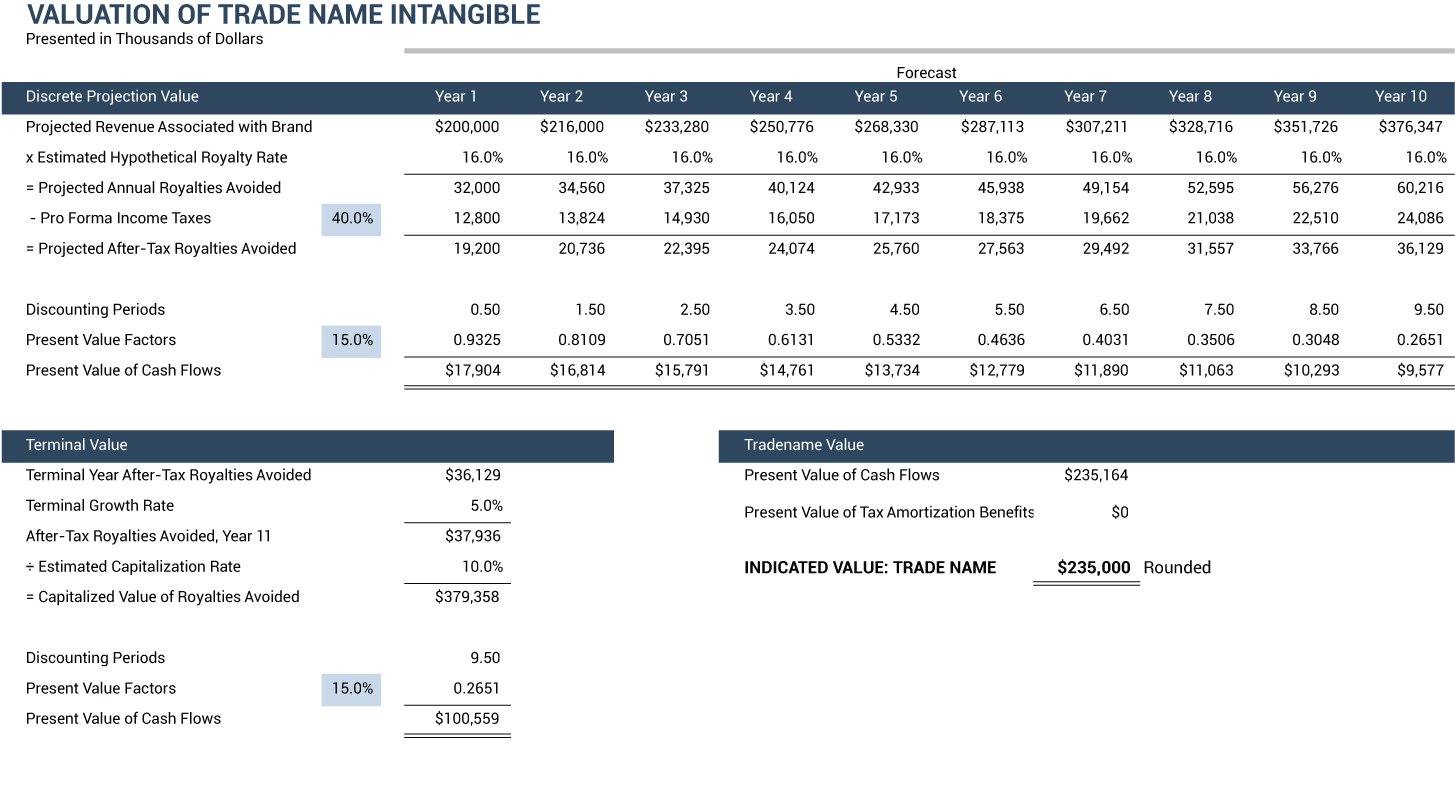
The professionals at Mercer Capital are experienced in valuing trademarks and trade names in numerous industries. Please contact us to find out how we can help you measure the fair value of acquired intangibles.
Endnotes
1 Diamond Foods, Inc. Form 10-Q, October 31, 2010.
2 ASC 805-20-55, paragraph 16.
5 Things to Know About the Draft AICPA Guide on In-Process Research and Development Assets
The AICPA released a draft accounting and valuation guide for “Assets Acquired to Be Used in Research and Development Activities” in November 2011. The guide replaces the 2001 practice aid “Assets Acquired in a Business Combination to Be Used in Research and Development Activities: A Focus on Software, Electronic Devices & Pharmaceutical Products.” The draft guide focuses on the treatment of acquired intangible assets that will be used in research and development efforts subsequent to the transaction (“In-Process R&D” or “IPR&D” assets). IPR&D assets also include assets expected to be used defensively to protect assets related to ongoing R&D projects. Here are five takeaways from the draft guide:
- Accounting Treatment – Initial Recognition. Acquired IPR&D projects generally satisfy the conditions necessary to be considered identifiable assets. Accordingly, current accounting guidance requires an acquirer to recognize (i.e. capitalize) IPR&D assets at their acquisition-date fair values following a business combination. In contrast, costs associated with intangible assets procured outside of a business combination (through an asset acquisition, for instance) to be used in R&D projects are capitalized only if they are deemed to have alternative future uses.
- Accounting Treatment – Subsequent Measurement. Capitalized IPR&D assets are considered to be indefinite lived until the related R&D projects are complete or abandoned. Indefinite lived intangible assets are not amortized but tested for impairment on an annual basis, or more frequently if there are indications that the assets may be impaired. The Financial Accounting Standards Board recently issued a proposed Accounting Standards Update that would grant companies the option to assess qualitative factors before employing quantitative impairment tests. Assets that may arise from completed or abandoned R&D projects no longer constitute IPR&D assets.
- Valuation Approach and Methods. Valuation methods generally fall into one of three approaches: cost, market or income. Determining replacement cost for an asset that builds on unique or proprietary technology with uncertain market prospects is typically unreliable, which renders methods under the cost approach unsuitable for measuring the fair value of IPR&D assets. The market approach is generally untenable because transactional data on sufficiently comparable assets are not likely to be available. By default, therefore, methods under the income approach are most appropriate in measuring the fair value of IPR&D assets. Such methods include the multi-period excess earnings method, relief from royalty method, decision tree analysis, with-and-without analysis, and various simulation methods.
- Prospective Financial Information. Application of the income approach relies on prospective financial information (“PFI”) tailored to the IPR&D asset being valued. Asset-specific PFI is extracted from enterprise-level PFI after adjustments to remove items not related to the IPR&D asset. Valuation specialists develop PFI for companies after careful evaluation of available information including management perspectives, acquisition models, internal budgets and forecasts, marketing presentations, board presentations, or analyses prepared by third-parties. In the case of business combinations, PFI should reconcile with the corresponding final purchase price. Fair value measurement prescribes the development of appropriate PFI from a market participant perspective, which requires careful examination of potentially idiosyncratic elements specific to (parties involved in) the particular transaction.
- Documentation and Disclosure. Valuation specialists help minimize the time, effort and costs associated with the fair value measurement and review process by carefully recording information sources, assumptions, adjustments and rationale for the techniques or methods underlying the valuation analyses. Such documentation also facilitates satisfaction of disclosures requirements prescribed by the relevant financial reporting standards.
Mercer Capital provides a range of fair value measurement services to financial managers. Please contact us to explore how we can help you measure and document the fair value of IPR&D assets.
FASB Modifies Goodwill Impairment Test
On August 10, 2011, the FASB approved a pending exposure draft, "Testing Goodwill for Impairment.” The revision to the accounting standards codification adds an optional qualitative assessment (referred to by some as the “Step Zero” test) to the annual goodwill impairment testing process. If, on the basis of an assessment of various qualitative factors, the reporting entity determines that it is more likely than not (i.e., a greater than 50% likelihood) that the fair value of a reporting unit exceeds its carrying value, the fair value of the reporting unit need not be measured. In other words, Step 1 of the goodwill impairment test will no longer be required if a reporting unit passes the qualitative Step Zero assessment.
The paragraphs added to Topic 350 (350-20-35-3A through 350-20-35-3G) include examples of events and circumstances that should be evaluated in preparing the qualitative assessment. The examples cited encompass macroeconomic, industry, market, and firm-specific factors.
A few things to keep in mind regarding this new addition to the codification:
- The standard provides little guidance regarding what will constitute appropriate documentation of the Step Zero test. It remains to be seen how auditors will evaluate the reliability of such qualitative assessments.
- The qualitative assessment is optional. Reporting entities may, at their discretion, elect to proceed directly to Step 1 fair value measurement of the reporting unit.
- While the standard is not effective until financial years beginning after December 15, 2011, early adoption is permitted.
- While the perceived need for the modification was attributed by the FASB to private companies, it applies to both private and public reporting entities.
The fair value reporting terrain continues to be rugged and uncertain. We are here to help. If you would like to discuss in confidence how the Step Zero test might apply to your company, please give one our experienced professionals a call.
Valuation of Contingent Consideration in M&A Transactions
Companies often use contingent consideration when structuring M&A transactions to bridge differing perceptions of value between a buyer and seller, to share risk related to uncertainty of future events, to create an incentive for sellers who will remain active in the business post-acquisition, and other reasons. Starting when SFAS 141R (now ASC 805) became effective in 2009, acquiring entities are now required to record the fair value of earn-outs and other contingent payments as part of the total purchase price at the acquisition date. This rule came into effect in the aftermath of the financial crisis when M&A activity slowed to a stand-still. Given the recent experience and continued expectation of increases in M&A activity, a refresher on the new rules may be helpful for CFOs and controllers of companies contemplating acquisitions in 2011.
The Rules
ASC 805, the section of the FASB codification that addresses business combinations, requires that:
- The fair value of contingent consideration be recognized and measured at fair value at the acquisition date. In most cases, recognition of a liability for contingent consideration will increase the amount of goodwill recognized in the transaction.
- Fair value must be re-measured for each subsequent reporting date until resolution of the contingency, and any increases or decreases in fair value will show up on the income statement as an operating loss or gain.
What Is Fair Value?
In the case of contingent consideration, fair value represents the amount the reporting entity would have to pay a hypothetical counter-party to transfer responsibility for paying the contingent liability. This amount is basically the present value of the probability-weighted expected amount of the future payment.
Valuation Procedures
The complexity of the procedures necessary to estimate the future payment ultimately depends on the structure of the earn-out.
- For an earn-out structured as a straight multiple of revenue or EBITDA, it may be reasonable in many cases to estimate the expected payment using a single-scenario model by applying that multiple directly to the measure of performance in the financial forecast.
- For a fixed amount payable upon achieving a particular milestone or event, estimating probabilities of various scenarios in a multi-scenario model will be necessary.
- For more complicated earn-outs including thresholds, caps, or tiers, a more complicated modeling technique such as a Monte Carlo simulation or real options analysis will be required. Preparing these analyses generally requires specialized training and software.
Valuation Inputs
For earn-out structures including milestone payments or tiered schedules, the fair value of the contingent payment is generally most sensitive to the estimate of the probability-weighted expected payment (rather than other inputs such as duration of contingency or discount rate). Developing reasonable estimates of the probability of future events is inherently difficult, but the use of decomposition and cross-checks will help improve the quality of these estimates. Decomposition is the process of breaking down a big event (such as commercialization of a development-stage product) into a series of smaller, more familiar pieces to make the probability estimate process easier. Cross-checks using aggregate industry information (such as the average length of time to receive regulatory approval from the FDA) can be helpful to validate assumptions that by nature rely on judgment. Industry expertise can be extremely valuable when selecting a valuation specialist to help with estimating the fair value of contingent consideration. An expert will be able to decompose common pathways into a series of managable steps to estimate, will have familiarity with available industry data that can be used to help support assumptions, and will be able to effectively explain and defend the assumptions.
Role of a Valuation Specialist
In most cases, you or someone else in your company will likely be the individual most knowledgeable of the potential outcomes. The role of the valuation specialist is to integrate this information into the appropriate valuation model, test it for reasonableness, and to articulate the nuances of the inputs and valuation model in such a way that is clear for auditors and other third-party reviewers to understand. For simple situations it may not be necessary to bring in the outside help of a valuation specialist. For more complicated situations requiring multiple scenarios or Monte Carlo analysis, however, outside support may be necessary. If you have any questions regarding the valuation of contingent consideration or the impact of particular structures on financial reporting procedures, feel free to contact us in confidence.
Do Not Pass Go…New Goodwill Impairment Rules for Negative Reporting Unit Carrying Values
In December 2010, the FASB issued ASU 2010-28, which updated rules pertaining to the appropriate measure of reporting unit carrying value. Historically, the carrying value of a reporting unit could be measured on an equity or total capital basis, as long as it was compared to the corresponding measure of value for the Step 1 goodwill impairment test. ASU 2010-28 mandates that reporting unit carrying value can only be measured on an equity basis. Under the Step 1 impairment test which compares reporting unit carrying value to fair value, any reporting unit with a zero or negative equity carrying value automatically passes the test (because the fair value of an equity stake generally cannot be less than zero).
New Step 2 Criteria
To address this issue, ASU 2010-28 introduces the new requirement that any reporting unit with zero or negative carrying value must automatically perform Step 2 of the goodwill impairment test if it is more likely than not that a goodwill impairment exists. The update provides a list of qualitative factors that should be considered in making this "more likely than not" determination, examples of which include:
- A significant adverse change in legal factors or in the business climate
- An adverse action or assessment by a regulator
- Unanticipated competition
- Loss of key personnel
Effective Dates
For public entities, the update is effective for fiscal years beginning after December 15, 2010. For non-public entities, the update is effective for fiscal years beginning after December 15, 2011, but early adoption is permitted.
Increasing Scrutiny for Fair Value Measurements
The Public Company Accounting Oversight Board (PCAOB) recently released the Report on Observations of PCAOB Inspectors Related to Audit Risk Areas Affected by the Economic Crisis which identified instances where auditors failed to comply with PCAOB standards. The document specifically references a number of fair value-related items including goodwill impairment, intangible assets, contingencies, complex or illiquid financial assets, and other fair value measurements.
Here are some tips for reporting entities to keep in mind through 2011 and 2012:
- Expect additional scrutiny regarding fair value measurements. The report specifically states that PCAOB inspectors will focus on these identified issues when planning future inspections. Auditors will likely allocate greater time for the review of inputs and methods used in estimating fair value measurements.
- Be deliberate in preparing financial projections. Financial forecasts are often the input that fair value measurements will be most sensitive to, and they are also often the most difficult to defend. Make sure there is a reasonable basis for each assumption underlying a financial projection, and that inputs are consistent with relevant corroborating evidence such as industry trends, expectations for economic recovery, and historical financial performance.
- Make sure that valuation assumptions and methods are properly documented. If you use an outside valuation specialist, they should provide a valuation report that clearly explains the valuation methods used in the analysis and thoroughly documents the sources and supporting evidence for assumptions. When reviewing the report, ask for clarification for inputs you don't recognize or explanation for valuation procedures you don't understand.
- Communicate with your auditors and their valuation team. Particularly for first-time or unusual valuation situations, we always recommend taking the time to communicate with your auditors and the reviewing valuation team on the front end. This practice is now even more important. The review process will be far less painful when all parties have the same expectations regarding selection of valuation methods and specification of significant assumptions.
At Mercer Capital, our goal is to minimize the hassle and disruption of the fair value measurement and review process for all parties involved, including company management, the audit team, and the auditor’s valuation review team.
5 Things To Watch For In Year-End Portfolio Company Fair Value Measurements
When it comes to portfolio company fair value measurement and reporting, 2011 lacked the drama of 2008 and 2009. New procedures and policies spawned by SFAS 157 (now Topic 820) have hardened into established routines, the FASB did not offer any new crisis-related guidance, and (with the exception on a rather petulant August) financial markets were reasonably well-behaved. Nonetheless, private equity fund managers – and their limited partners – cannot take fair value measurement for granted. To help ensure that the upcoming year-end portfolio fair value measurement process is as uneventful as it should be, we have created the following checklist to help fund managers measure the fair value of portfolio company investments.
- Are you using the right valuation methods? In our experience, valuation methods under the market approach are most commonly used for portfolio company fair value measurement. However, the prolonged economic limbo we are experiencing may increase the relevance of other approaches. For example, a discrete cash flow forecast over the intermediate term may be appropriate for companies in cyclical industries. If a company’s earnings remain depressed, valuation methods under the asset-based approach may be worthy of consideration.
- Are you using the right guideline group? When using the guideline company method under the market approach, last year’s group is not necessarily the best group this year. Changes in the business model or strategy at the portfolio company may have rendered one or more of the legacy guideline companies insufficiently comparable, or may call for inclusion of certain companies previously excluded. In addition, guideline companies may have made acquisitions or divestitures during the year that limit their continued relevance to the portfolio company.
- Are you carefully vetting cash flow forecasts? The “auditability” of a fair value measurement under the income approach will be enhanced by a rigorous analysis of underlying cash flow forecasts. This is simply the basic blocking and tackling of sound financial analysis: What is projected unit volume and pricing? How do projected margins relate to the inherent operating leverage of the business? Are projected results achievable with existing corporate infrastructure? If not, what capital expenditures will be required? How do projected growth rates compare to the industry – is the portfolio company expected to lose, maintain, or capture market share?
- Are you reconciling to prior fair value measurements? Relying on the historical cost of the investment alone is no longer sufficient for fair value measurement. Is there a compelling narrative that relates the fair value measurement at December 31, 2010 with prior measurement dates, taking into account changes in portfolio company performance and expectations, changes in market multiples, recent transactions, and the like? Despite mid-year volatility, financial markets are basically flat year-over-year; how does the fair value of your portfolio company relate? Reconciling to prior fair value measurements is a critical element in enhancing the credibility of your analysis and conclusion.
- Are you double-checking your math? Excel will do a lot of great things, but it will not alert you to the missing or extraneous cell reference in your formula. Nothing is more embarrassing – or avoidable – than a computational error. Developing and implementing a consistent process for checking the arithmetic in your valuation worksheets is an essential internal control.
Mercer Capital provides a range of fair value measurement services to investment fund managers. We are always happy to discuss your valuation issues in confidence as you plan for the year-end fair value measurement cycle. Give us a call today.
5 Things To Know about Proposed Changes to ASC Topic 820
The FASB issued an exposure draft regarding a broad range of proposed amendments to Topic 820 on June 29, 2010, with a comment period extending through September 7, 2010. The exposure draft is part of the ongoing convergence project and is intended to more closely align fair value measurements under U.S. GAAP and IFRS. For the sake of our busy friends and colleagues who may not have reviewed the exposure draft yet, we offer a quick overview of some of the more significant proposed changes.
- The title of Topic 820 will be shortened to Fair Value Measurements. This change does not signal a de-emphasis on disclosure (the exposure draft expands required disclosures) but rather seems to be consistent with the view that measurement and disclosure are inextricably intertwined.
- The concept of “highest and best use” is restricted to non-financial assets only. The concept of highest and best use is rooted in the appraisal of real assets that have alternative uses. As financial assets and liabilities rarely have multiple uses, application of the highest and best use concept to such instruments was vexing (and, in practice, often ignored). Nonetheless, to the extent the fair value of a financial asset or liability has been measured with reference to the highest and best use provisions of Topic 820, the proposed changes would require a new valuation rationale.
- The “in use” and “in-exchange” premises are removed. All references to “in-use” and “in-exchange” values have been purged from Topic 820 on the grounds that the terms were needlessly confusing. The offending terms have been replaced with language clarifying whether the subject asset would be used in combination with other assets and liabilities or on a standalone basis.
- The appropriate use of valuation discounts and premiums is confirmed. The proposed changes continue the existing prohibition on the application of blockage discounts in Level 1 measurements, likening the blockage discount to a transaction cost that accompanies sale of the asset, but not an attribute of the asset itself. However, other valuation discounts and premiums – such as control premiums and minority interest discounts – receive the approval of the FASB for application under appropriate circumstances.
- The disclosure requirements for Level 3 fair value measurements are expanded. The proposed changes include addition of “measurement uncertainty analysis” to aid financial statement users in assessing the effect of alternative assumptions regarding unobservable inputs on the fair value measurement. The disclosures would also include assessment, on a qualitative basis, of correlation between various unobservable inputs. The FASB cautions that the purpose of the analysis is not to contemplate remote scenarios or describe the expected change in a fair value measurement due to future economic changes. The exposure draft provides a disclosure example, but provides no guidance regarding the range of assumptions to be disclosed. Despite assurances from the FASB that these disclosures are not meant to provide financial statement users with information for second guessing fair value measurements, some reporting entities are likely to chafe against this proposed change.
The pace of change at the FASB and IASB shows no signs of slackening. At Mercer Capital, we continue to monitor these developments so we can help make fair value measurement as painless as possible for our clients and their auditors. Our financial statement reporting professionals are always eager to discuss your fair value reporting issues in confidence. Give us a call today.
Reprinted from Mercer Capital’s Financial Reporting Valuation Flash, originally published August 30, 2010.
Fair Value for Impairment Testing
Standard of Value
Every valuation assignment begins with a determination of the appropriate definition, or standard, of value. The standard of value provides guidance about how value is determined and from what perspective. The appropriate standard of value for most financial reporting valuation assignments, including impairment testing, is fair value, as defined in ASC 820.
Note that fair value is different than other standards of value such as fair market value or the legally-defined statutory fair value.
Fair value is defined in the glossary of ASC 820 as “the price that would be received to sell an asset or paid to transfer a liability in an orderly transaction between market participants at the measurement date.” Fair value assumes a hypothetical transaction for the subject asset or liability at the measurement date. ASC 820 provides additional clarification related to the nature of this hypothetical transaction, which we summarize below.
Market Exposure
ASC 820 explicitly states that fair value assumes exposure to the relevant market for a sufficient period of time for normal marketing activities. The hypothetical transaction is not a forced liquidation or distressed sale. However, it does reflect prevailing market conditions.
Exit Price
Fair value is measured from the perspective of the owner of the asset. In other words, it is measured as the price that would be received to sell an asset (exit price) rather than the price that would be paid to acquire an asset (entry price). In the context of measuring the fair value of a reporting unit, exit and entry prices are often indistinguishable.
Relevant Market
According to ASC 820, the hypothetical transaction occurs in the “principal market” for the asset, or if there is no principal market for the asset, the hypothetical transaction occurs in the “most advantageous market” for the asset. The principal market is defined as “the market in which the reporting entity would sell the asset… with the greatest volume and level of activity….” In the context of ASC 350, there is generally no principal market for reporting units (or intangible assets); unlike securities, reporting units are not homogenous assets with active markets. So what is the most advantageous market?
The most advantageous market is defined as “the market in which the reporting entity would sell the asset… with the price that maximizes the amount that would be received for the asset… considering transaction costs in the respective markets.” Depending on the circumstances surrounding a particular situation, the most advantageous market for a reporting unit could be the market made up of strategic buyers or the market made up of financial buyers. In any case, the most advantageous market is ultimately defined by the relevant market participants, as we will discuss later.
While transaction costs should be included in the consideration of the most advantageous market for the given asset, these costs must be excluded from the fair value measurement itself. Transactions are an attribute of a market rather than the subject asset itself, and as such, they are not a component of the “price that would be received”.
Market Participants
Fair value is defined from the perspective of market participants rather than a specific party, such as the reporting entity. A market participant is defined as 1) an unrelated party, 2) knowledgeable of the subject asset, 3) able to transact, and 4) motivated but not compelled to transact. In the context of the most advantageous market, potential market participants could be existing industry players, companies looking to enter the industry, private equity investors, or other parties.
ASC 820 clarifies that it is not necessary to identify specific market participants, but rather the characteristics that distinguish market participants in the given situation should be identified. For example, private equity investors generally rely on different funding sources than large operating companies; this is a distinguishing characteristic that would be relevant in the context of fair value.
Fair value is determined with reference to the assumptions market participants would use in valuing the subject asset or liability; assumptions used by the reporting entity may not be consistent with those made by market participants.
Highest & Best Use
Fair value also assumes that an asset will be employed in its highest and best use by market participants. Highest and best use is defined in ASC 820 as the use that would maximize the value of the asset or group of assets within which the subject asset would be used. Fair value should be determined based on the hypothetical transaction price assuming the asset would be used within the “highest and best use” asset group, and that the other assets in that group would be available to market participants. If an asset is most valuable outside the context of any other assets, the fair value should be measured based on a hypothetical transaction of the asset on a stand-alone basis.
For reporting units, the use of an “in-use” or “in-exchange” valuation premise is not often controversial. The delineation of the likely market participants is often more significant in determining the degree to which synergies with potentially complementary businesses ought to be reflected in the fair value measurement.
Valuation Techniques & Inputs
Having discussed the definition of value pertinent to goodwill impairment testing, we will introduce some foundational valuation concepts in the following sections.
Approaches to Value
Generally accepted valuation theory (as well as ASC 820) recognizes three general approaches to valuation. , Within each approach, a variety of valuation methods (or techniques) can be applied to fair value measurement in a given situation. ASC 820 states that valuation techniques consistent with these approaches should be used to measure fair value.
- The income approach converts a stream of expected future economic benefits into a single present value. Valuation methods under the income approach generally include variations of two techniques: single-period capitalization and discounted cash flow analysis. Option pricing models can also be used under the income approach in certain situations.
- The market approach uses prices and other relevant information generated by market transactions involving identical or comparable assets or liabilities (including a business) to determine value. Market methods compare the subject with transactions involving similar investments, including publicly traded guideline companies and sales involving controlling interests in public or private guideline companies. Consideration of prior transactions in interests of a valuation subject is also a method under the market approach.
- In the context of business valuation, the cost approach is often described as an asset-based approach under which value is measured with reference to the values of the individual assets and liabilities of the reporting unit.
In the context of measuring the fair value of a reporting unit for purposes of the Step 1 goodwill impairment test, valuation techniques under the market and income approaches are generally most appropriate. Business valuation techniques under the cost approach frequently do not capture the value of goodwill and certain other intangible assets; in such cases, the resulting valuation indications would not be consistent with the objective of measuring fair value.
Fair Value Hierarchy
Inputs to the various valuation techniques may be either observable or unobservable. ASC 820 contains a hierarchy which prioritizes inputs into three broad levels:
- Level 1 inputs are observable quoted prices in active markets for identical assets;
- Level 2 inputs generally include observable quoted prices for similar assets in active markets or quoted prices for identical assets in markets that are not active; and,
- Level 3 inputs are unobservable inputs that are developed based upon the best information available under the circumstances, which might include the reporting entity’s own data.
Fair value measurements should rely on the highest level inputs available. ASC 820 notes that the availability of inputs can impact the selection of valuation techniques, but clarifies that the hierarchy prioritizes valuation inputs, not techniques.
Fair value measurements for impairment testing tend to rely heavily on Level 3 inputs, but can also include Level 2 inputs. Common inputs include:
- Projected financial performance for a reporting unit (Level 3) ;
- Market pricing information for publicly traded guideline companies (Level 2);
- Pricing information for recent control transactions in similar businesses (Level 3);
- Cost of capital estimates (Level 2 or Level 3);
- Other inputs
By their nature, unobservable inputs cannot be derived from external market information. Accordingly, unobservable inputs should reflect the reporting entity’s own assumptions about the assumptions that market participants would use in pricing the asset or liability.
Reprinted from Mercer Capital’s Value Added (TM), Vol. 22, No. 1, May 2010
Why Quality Matters in Valuation for Equity Compensation Grants
For privately held companies (particularly those sponsored by private equity and venture capital funds), getting the valuation process right the first time for equity compensation grant compliance is always the least expensive route in terms of both direct and indirect cost.
- Review by Auditors. The potential for surprises in the audit review process related to equity compensation is most significant with new auditors and for new equity compensation plans. It is not necessarily safe to assume that valuation procedures used in the past will be sufficient to pass the audit review process. Communication with auditors on the front end in this situation is paramount to make sure that valuation procedures (or the independent valuation provider) will be satisfactory. Valuation analysis is always more expensive when it has to be done twice.
- SEC Scrutiny. Preparing for an IPO is probably the worst time for a company to deal with fallout related to insufficient valuation procedures related to equity compensation. This situation quickly becomes very expensive. And the direct financial cost of compliance in this situation is often less burdensome than the distraction created at a time so close to the finish line when management most needs to be focused on execution of strategic objectives. For companies with even a distant prospect of IPO, robust valuation procedures for equity compensation compliance are necessary on the front-end.
- IRS Review. Even for companies not contemplating a potential IPO, the possible tax penalties from IRC 409A make defensible valuation analysis a priority. Given the short life of IRC 409A as of this drafting, there is limited case history to develop clear expectations of IRS scrutiny related to 409A compliance. We do know that IRS audits related to 409A have begun picking up, and it’s likely that valuation reviews will follow suit. Drawing on our experience in other tax-related valuation matters, we know that thorough documentation and sound economic reasoning ultimately win the day. Given this uncertainty and magnitude of the consequences of 409A, it’s best to play it safe.
In general, it is safe to expect the level of scrutiny over equity compensation-related valuation to increase with the size of the equity compensation grant – both the absolute magnitude (in terms of dollars) and relative magnitude (as a percentage of total revenue or enterprise value). While complexity of the equity compensation grant or capital structure does not inherently increase scrutiny, it does make it more challenging to demonstrate clear compliance with tax and financial reporting regulations. With appropriate awareness, management can minimize total compliance cost by selecting valuation procedures appropriate to the situation and getting it right the first time.
Reprinted from Mercer Capital’s Financial Reporting Valuation Flash, April 2010.
Contingent Consideration: 5 Things to Remember
With many acquirers spending 2009 on the sidelines, the new accounting treatment for contingent consideration arrangements under SFAS 141R remains largely untested. When markets thaw, however, we expect that acquirers will be anxious to make up for lost time, and a resumption of deal activity will spark new conversations with auditors regarding the appropriate treatment of earnouts and other forms of contingent consideration.
As an expression of our faith in the future of the economy, we offer a few cautionary notes regarding the accounting for contingent consideration.
- Auditors will expect detailed, supportable analysis regarding fair value. It may seem that the fair value of a contingent consideration agreement is unknowable; after all, if you and the seller could have reached an agreement on price, you would have. However, the FASB believes that fair value can be reasonably estimated. From the standpoint of your auditors, the midpoint of the potential payout range is not sufficient. Be prepared to offer reasoned probability assessments regarding the range of likely outcomes.
- Fair value measurement for contingent consideration liabilities can be complex. Estimating the fair value of contingent consideration liabilities requires a different set of tools than that ordinarily applied to measure the fair value of assets. Expected value techniques for cash flow estimation and discount rate development will be much more prevalent when determining the amount that would be paid to a market participant to assume the contingent consideration liability. This is a subtle, but significant shift from determining the amount that would be received from a market participant in exchange for an asset.
- There is no one-size-fits-all valuation model. Every contingent consideration agreement is unique. With the wide array of potential performance metrics, measurement periods, performance hurdles, and payment terms, the valuation model will have to be tailored to each particular liability.
- Contingent consideration liabilities require ongoing monitoring and assessment. Veterans of fair value accounting for goodwill and other intangible assets have grown accustomed to annual impairment testing under SFAS 142 and 144. While there is no impairment testing for contingent consideration liabilities, remeasurement is required at every balance sheet date. So, for public companies, the ongoing monitoring and assessment requirements for contingent consideration can actually be more onerous than for goodwill or other intangible assets.
- A robust acquisition date fair value estimate is the best defense against future earnings volatility. The most common concern we hear from clients is the potential for future earnings volatility stemming from the requirement to remeasure the contingent consideration liability at each balance sheet date. An increase in fair value will result in a charge to earnings, while a decrease in fair value will trigger a credit to the P&L. While changes to fair value are inevitable, a well-reasoned estimate of fair value on the front end is the best tool for mitigating undesirable earnings volatility.
Reprinted from Mercer Capital's Financial Reporting Flash, published November 6, 2009.
A Guide to Reviewing a Purchase Price Allocation Report
Reviewing a purchase price allocation report can be a daunting task if you don’t do it for a living – especially if you aren’t familiar with the rules and standards governing the allocation process and the valuation methods used to determine the fair value of intangible assets. While it can be tempting as a financial manager to leave this job to your auditor and valuation specialist, it is important to stay on top of the allocation process. Too often, managers find themselves struggling to answer eleventh hour questions from auditors or being surprised by the effect on earnings from intangible asset amortization. This guide is intended to make the report review process easier while helping to avoid these unnecessary hassles.
Please note that a review of the valuation methods and fair value accounting standards is beyond the scope of this guide. Grappling with these issues is the responsibility of the valuation specialist, and a purchase price allocation report should explain the valuation issues relevant to your particular acquisition. Instead, this guide focuses on providing an overview of the structure and content of a properly prepared purchase price allocation report.
General Rules
While every acquisition will present different circumstances that will impact the purchase price allocation process, there are a few general rules common to all properly prepared reports. From a qualitative standpoint, a purchase price allocation report should satisfy three conditions:
- The report should be well-documented. As a general rule, the reviewer of the purchase price allocation should be able to follow the allocation process step-by-step. Supporting documentation used by the valuation specialist in the determination of value should be clearly listed and the report narrative should be sufficiently detailed so that the methods used in the allocation can be understood.
- The report should demonstrate that the valuation specialist is knowledgeable of all relevant facts and circumstances pertaining to the acquisition. If a valuation specialist is not aware of pertinent facts related to the company or transaction, he or she will be unable to provide a reasonable purchase price allocation. If the report does not demonstrate this knowledge, the reviewer of the report will be unable to rely on the allocation.
- The report should make sense. A purchase price allocation report will not make sense if it describes an unsound valuation process or if it describes a reasonable valuation process in an abbreviated, ambiguous, or dense manner. Rather, the report should be written in clear language and reflect the economic reality of the acquisition (within the bounds of fair value accounting rules).
Assignment Definition
A purchase price allocation report should include a clear definition of the valuation assignment. For a purchase price allocation, the assignment definition should include:
- Objective – The definition of the valuation objective should specify the client, the acquired business, and the intangible assets to be valued.
- Purpose – The purpose explains why the valuation specialist was retained. Typically, a purchase price allocation is completed to comply with GAAP financial reporting rules.
- Effective Date – The effective date of the purchase price allocation is typically the closing date of the acquisition.
- Standard of Value – The standard of value specifies the definition of value used in the purchase price allocation. If the valuation is being conducted for financial reporting purposes, the standard of value will generally be fair value as defined in SFAS 157.
- Statement of Scope and Limitations – Most valuation standards of practice require such statements that clearly delineate the information relied upon and specify what the valuation does and does not purport to do.
Background Information
The purchase price allocation report should demonstrate that the valuation specialist has a thorough understanding of the acquired business, the intangible assets to be valued, the company’s historical financial performance, and the transaction giving rise to the purchase price allocation.
Company Overview
Discussion related to the acquired company should demonstrate that the valuation specialist is knowledgeable of the company and has conducted sufficient due diligence for the valuation. The overview should also discuss any characteristics of the company that play a material role in the valuation process. The description should almost always include discussion related to the history and structure of the company, the competitive environment, and key operational considerations.
Intangible Assets
The intangible assets discussion should both provide an overview of all relevant technical guidance related to the particular asset and detail the characteristics of the asset that are significant to the valuation. The overview of guidance demonstrates the specialist is aware of all the relevant standards and acceptable valuation methods for a given asset.
After reading this section, the reviewer of the purchase price allocation report should have a clear understanding of how the existence of the various intangible assets contribute to the value of the enterprise (how they impact cash flow, risk, and growth).
Historical Financial Performance
The historical financial performance of the acquired company provides important context to the story of what the purchasing company plans to do with its new acquisition. While prospective cash flows are most relevant to the actual valuation of intangible assets, the acquired company’s historical performance is a useful tool to substantiate the reasonableness of stated expectations for future financial performance.
This does not mean that a company that has never historically made money cannot reasonably be expected to operate profitably in the future. It does mean that management must have a compelling growth or turn-around story (which the specialist would thoroughly explain in the company overview discussion in the report).
Transaction Overview
Transaction structures can be complicated and specific deal terms often have a significant impact on value. Purchase agreements may specify various terms for initial purchase consideration, include or exclude specific assets and liabilities, specify various structures of earn-out consideration, contain embedded contractual obligations, or contain other unique terms. The valuation specialist must demonstrate a thorough understanding of the deal terms and discuss the specific terms that carry significant value implications.
Fair Value Determination
The report should provide adequate description of the valuation approaches and methods relevant to the purchase price allocation. In general, the report should outline the three approaches to valuation (the cost approach, the market approach, and the income approach), regardless of the approaches selected for use in the valuation. This demonstrates that the valuation specialist is aware of and considered each of the approaches in the ultimate selection of valuation methods appropriate for the given circumstances.
Depending on the situation, any of a number of valuation methods could be appropriate for a given intangible asset. While selection of the appropriate method is the responsibility of the valuation specialist, the reasoning should be documented in the report in such a way that a report reviewer can assess the valuation specialist’s judgment.
At the closing of the discussion related to the valuation process, the report should provide some explanation of the overall reasonableness of the allocation. This discussion should include both a qualitative assessment and quantitative analysis for support. While this support will differ depending on circumstances, the report should adequately present how the valuation “hangs together.”
Something to Remember
A purchase price allocation is not intended to be a black box that is fed numbers and spits out an allocation. The fair value accounting rules and valuation guidance require that it be a reliable and auditable process so that users of financial statements can have a clear understanding of the actual economics of a particular acquisition. As a result, the allocation process should be sufficiently transparent that you are able to understand it without excessive effort, and the narrative of the report is a necessary component of this transparency.
Reprinted from Mercer Capital’s Value Matters (TM) 2007-10, October 2007.
